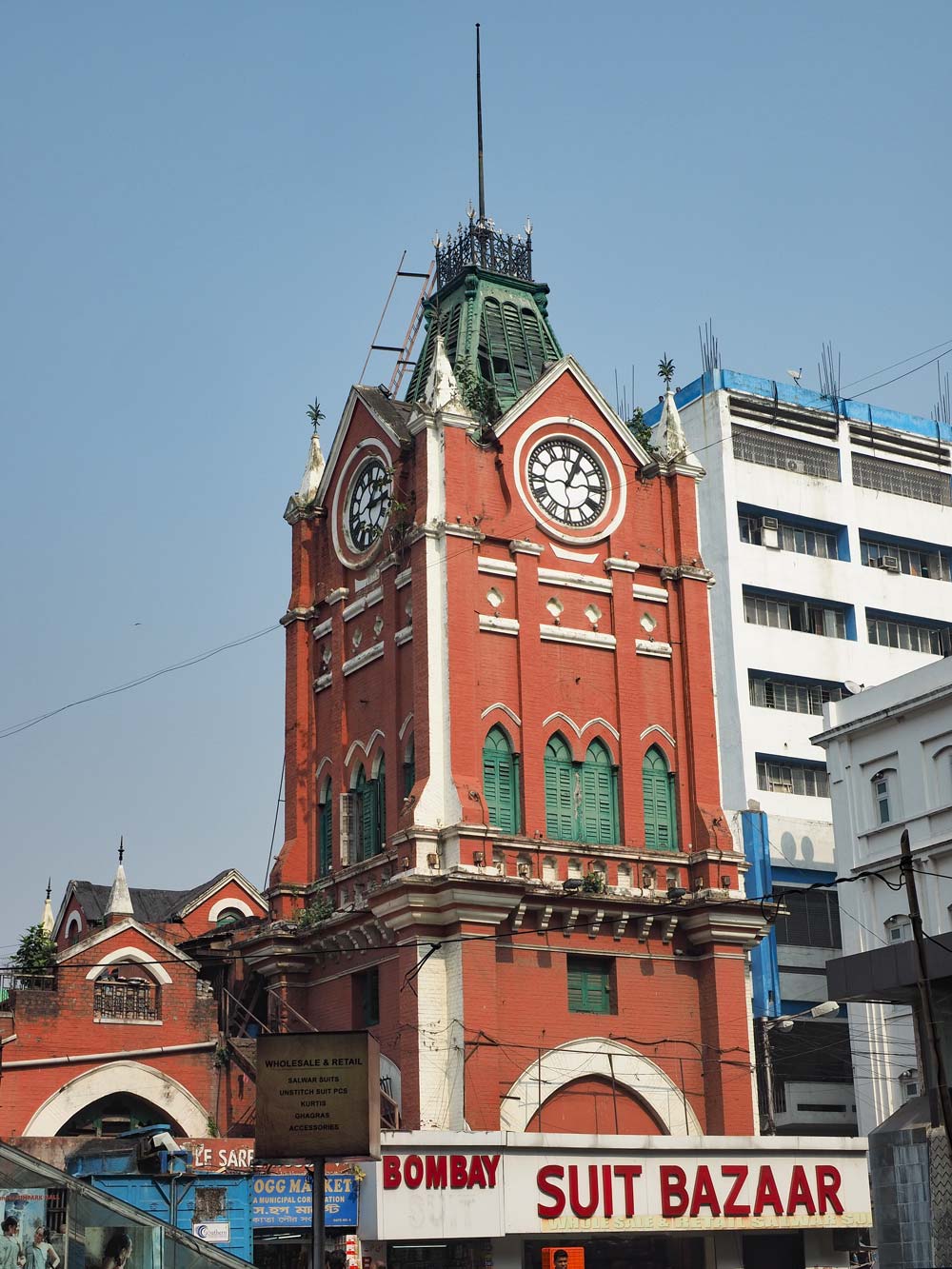
New Market Clock Tower
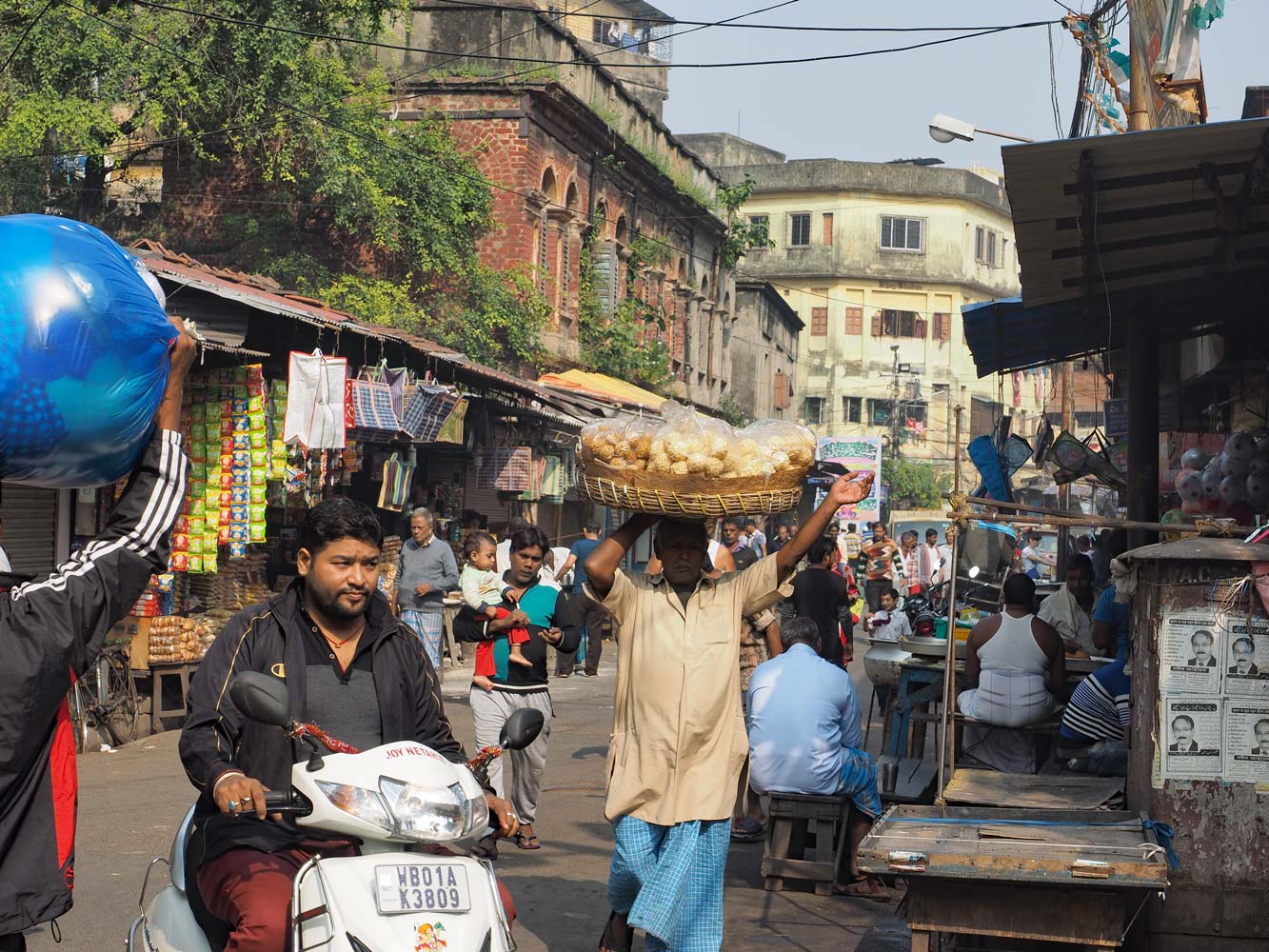
A typical busy street
21 Nov. Kolkata
The train kept getting delayed more and more as the night
wore on until the 13010 Doon Express finally pulled in about 3:15 a.m.—11 hours
late. No reason was ever given for the delay, though the announcement recordings
kept saying “the delay is deeply regretted.” Most of the train cars were three-tier
sleepers without air-conditioning, but I had the best class, two-tier air-conditioned.
No more breathing clouds of dust! On boarding, a steward gave me bedding and I settled
in for what little remained of the night. I had a lower berth, which is best because
it has a window and I could fold it back up into seats when I chose to in the morning.
Scenery on the northern plains tends to be of dull fields and trash-strewn villages,
but there’s a picturesque region of hills about half way. Last night and on the
train I relaxed and got in a lot of reading, finishing photography and travel magazines
among other things. Vendors regularly passed down the train’s aisle selling snacks
and simple meals, so life onboard was comfortable. If the train had been on schedule
I would have arrived at Kolkata’s Howrah Station, located just west from the city
across the Houghly River, bright and early at 6:55 a.m., but it wasn’t and took
until nearly 8 p.m. after a slow crawl through a massive rail yard.
My Airbnb host had sent detailed directions, which began with getting a pre-paid
taxi for 160 rupees, which seemed ridiculously cheap, though the driver was happy
with a 50-rupee tip. Most Kolkata taxis are wonderful old Hindustani Ambasadors,
based on the 1950s Morris Oxford series III of England and produced near Kolkata
from 1958 to 2014; story at
https://en.wikipedia.org/wiki/Hindustan_Ambassador.
My driver skillfully navigated the dense and chaotic traffic and took the immense
1943 Howrah Bridge over the Houghly River. It’s the sixth longest cantilever bridge
in the world and probably the busiest with an estimated daily load of 100,000 vehicles
and 150,000 pedestrians; history at
https://en.wikipedia.org/wiki/Howrah_Bridge.
A downside to visiting Kolkata is that the less expensive hotels tend to be poor
value and grimy. When looking online for accommodations, I didn’t find anything
particularly promising on TripAdvisor or booking.com, but Airbnb listed rooms in
homes or apartments that no doubt would be far nicer than a similarly priced hotel.
I’d never used Airbnb before, so went through the process of signing up, which required
submitting confirmation codes, identification (passport copy), and a self-portrait.
It all seemed to work OK in the end, and I made a booking with the relatively central
Kolkata Backpackers for the “Classical vintage Double room.” I would be staying
three nights at a cost of about $16/night, paid through PayPal. (Kolkata Backpackers
has a mention in Lonely Planet as a homestay hostel.) A lot of Kolkata listings
on Airbnb and Booking.com are far from the center, and would have been extremely
inconvenient with the city’s terrible traffic. My host showed me the upstairs room
with its four-poster bed and plethora of semi-antiques, then took me on the back
of his motorbike to Ajanta Hotel restaurant, where I had a good vegetarian thali.
I’ve visited Kolkata, India’s second largest city and the center of Bengali culture,
many times since my first India trip in 1983-84. It’s full of wonderful Indian and
colonial architecture, though quite a few buildings crumble from neglect and the tropical
climate. One sees relics long gone in the rest of the world, such
as the antique Ambassador taxis bumping along and the man-pulled rickshaws still
popular on the back streets. On this visit I’ll be taking in the art scene at museums
and galleries plus cultural performances. This is a great time of year to be in
Kolkata with pleasantly warm days and cool nights. Also the air is a bit cleaner
than in the Indian cities visited earlier on this trip.

New Market Clock
Tower
A
typical busy street
22 Nov. Kolkata
My room included a nice breakfast of vegetables, omelet, banana, toast, and tea.
I then headed north to the Sudder Street area—the most popular area for tourists—via
the cheap and rattling metro. Here I checked in with Backpackers-Sunderban Tour,
which runs the trip that I will take to the Sunderbans in two days time. Then to
the post office to mail 14 postcards written in Varanasi, paying only 15 rupees
(23 cents USD) each for stamps, probably the world’s cheapest international postage.
I don’t have any excuses not to write postcards now! A few men sat with typewriters
atop tiny tables in front of the post office, ready to handle any paperwork for
India’s bureaucracy. I did some shopping in the warren of lanes north of Sudder
Street before settling down for a palak paneer dinner at the multi-cuisine Blue
Sky Café, popular among both Indians and Westerners. Then, with nerve-wracking crossings
of busy streets, I made a long walk south to Rabindra Savan, where I watched several
groups of folk musicians, each with a soloist singing plaintive songs.
23 Nov. Kolkata
Another nice day began with a good breakfast. In the afternoon I headed north on foot to see some of Kolkata’s
street life and quirky architecture. Ajuha Museum for Arts
on Elgin Road presented a show of paintings that depict the human form in styles
that ranged from surrealistic to naturalistic to semi-abstract. Farther north on
Ho Chi Minh Sarani I dropped by the Harrington Street Arts Centre
and although it didn’t have any shows today, a room displayed atmospheric watercolors
of Kolkata street scenes. A bit to the west the art gallery of ICCR/Rabindranath
Tagore Centre
offered a highly varied show of paintings and photographs by visual arts students.
Then at 6 p.m. ICCR’s auditorium hosted “A Tribute to the Legends” with Bengali
dancing accompanied by beautiful singing of women soloists. Just to the west I passed
the American Consulate, which suffers the indignity of having its street address
renamed after the one-time nemesis Ho Chi Minh! I stopped at the upscale cafeteria
chain Haldiram for a very tasty North Indian vegetarian thali, then managed to avoid
the temptations of the cake and Indian sweets counters.
24 Nov. Sunderbans
I had long been keen to visit the great expanse of the Brahmaputra River’s delta
called the ‘Sunderbans,’ where tigers and crocodiles roam the mangroves. It’s southeast
of Kolkata and extends eastward into Bangladesh. The Lonely Planet guidebook recommends
going on a tour because of the complexity of arranging permits and transport. I
would go on a three-day, two-night excursion with Backpackers-Sunderban Tour
https://www.tourdesundarbans.com/ at a no-frills
cost of 5,500 rupees ($84.82), much less than what other tour companies charge.
The three brothers who run the tours know their stuff and did an excellent job of
organizing everything.
The manager of Kolkata Backpackers gave me a
ride on the back of his motorbike to the tour office on Tottee Lane, just off Sudder
Street, for the 8 a.m.-ish departure. We got on a tour bus and staff gave each of
us a vegetable sandwich and bottle of water. Getting out of central Kolkata took
a long time, of course, and we stopped on the edge at Science City to pick up more
passengers. Altogether our little group had two women from Italy, a young fellow
from Australia, myself, a couple Indian couples, and a solo Indian fellow. The highway
then followed a horribly filthy black river on our left and expansive wetlands on
the right. Farther along we journeyed past vast rice fields and maneuvered through
dusty villages, stopping once for a tea break. Nearing the end we crossed over a
big river, then arrived at Godkali on an even bigger river. Here we got on a flat-topped
boat (no seats, no lifejackets) powered by an ancient looking two-cylinder diesel
engine for a ride across to a bustling market town on the island of Gosaba.
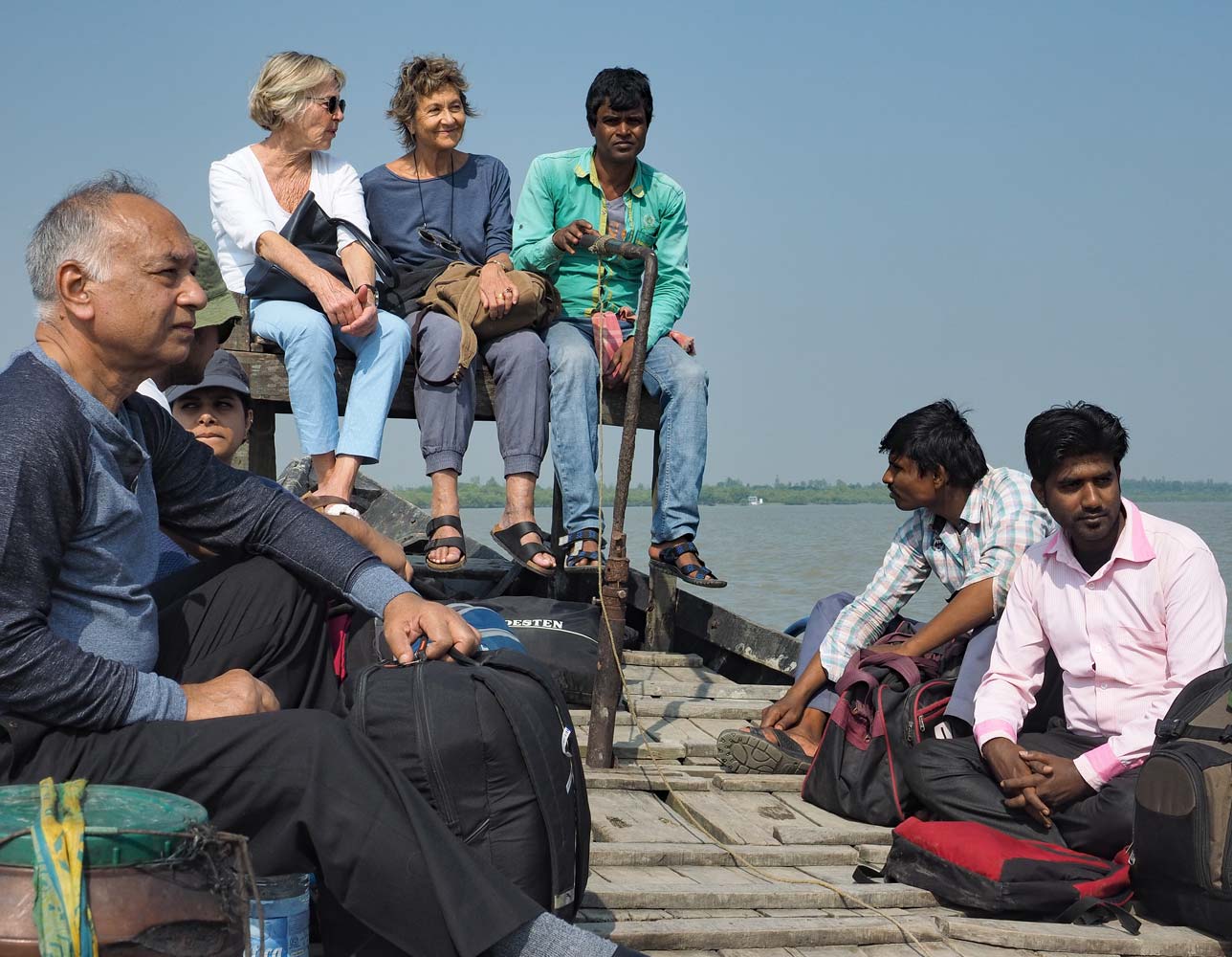
Our first boat ride
A rough ride on a three-wheeled contraption brought us across the island to another broad river, where a boat met us for a ride to our ‘eco village’ on the island of Satjelia. After a late lunch, our guide led us on a short walk through the surrounding village and rice fields, stopping at the Friday afternoon cockfight, where a large group of men gathered around an open area to assess each other’s birds, then pair them off for fights. Sharp metal spurs tied to each rooster’s leg made some of the contests short and deadly. Other birds didn’t feel like fighting, no doubt embarrassing their owners. This wasn’t my cup of tea and I was relieved when the guide finally led us away to a small boat rowed by a man with a single oar at the stern. We crossed the river to an area of mangroves and turned up a couple channels to look for wildlife. Our small and quiet boat let us get deep into the mangroves. A flock of lesser whistling ducks flew overhead, and we saw three kinds of kingfishers—black-capped, white-throated, and brown-winged—of the seven species here. Herons also winged by. On the muddy shores we saw two dog-faced water snakes, said to be mildly poisonous.
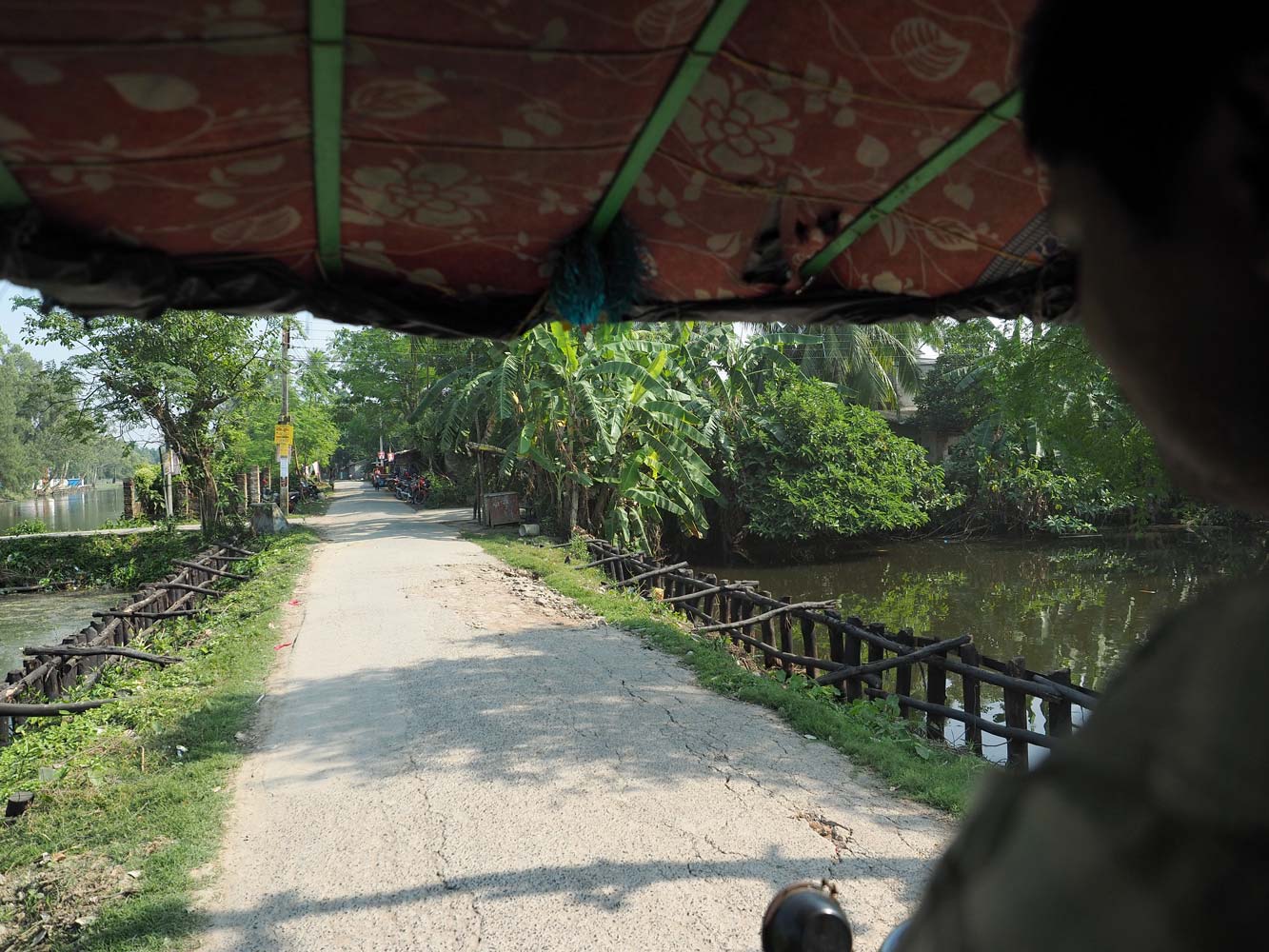
We travel across
this island in a large motorized three-wheeler.
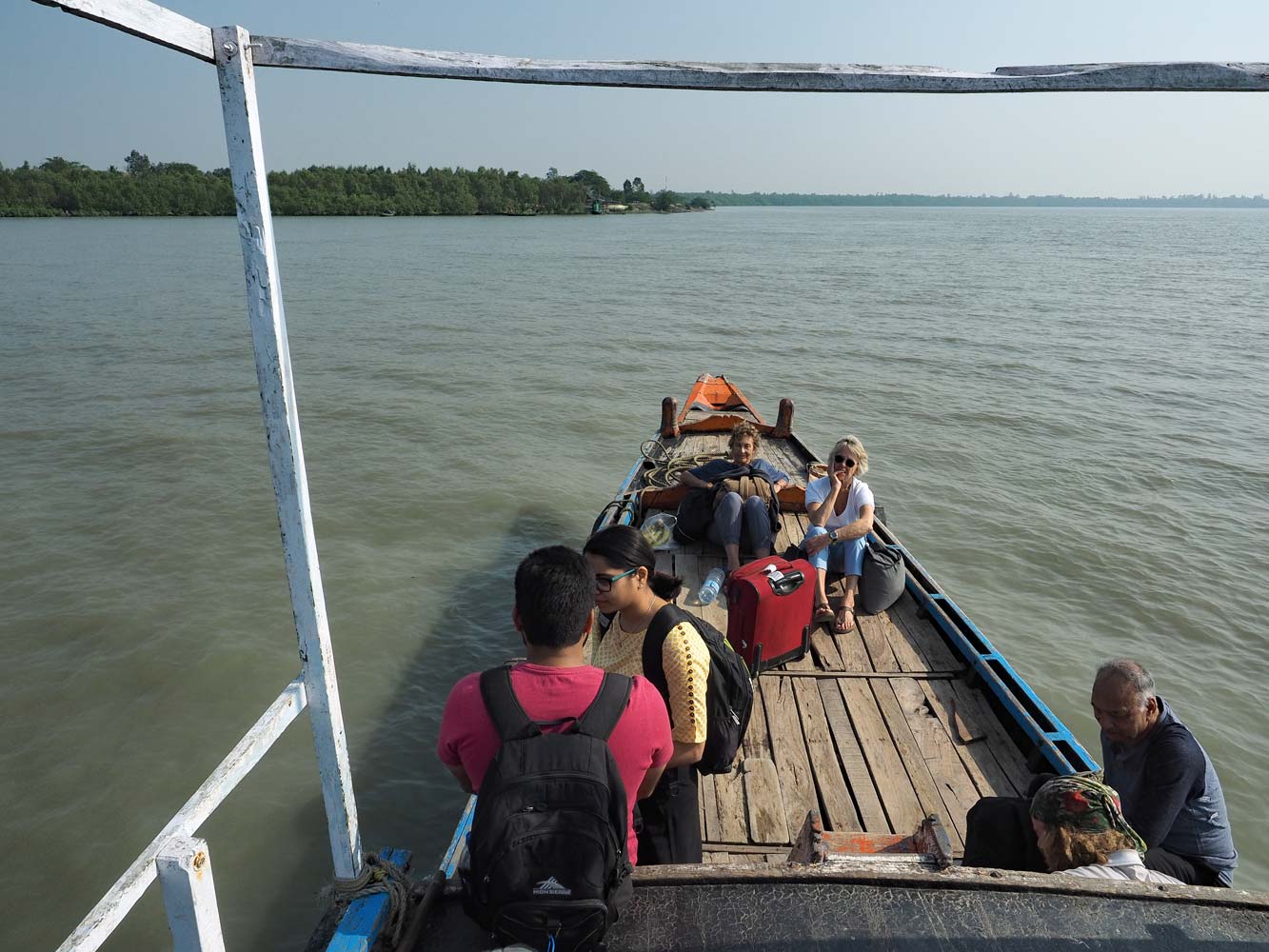
Then hop on this
boat to our eco village.
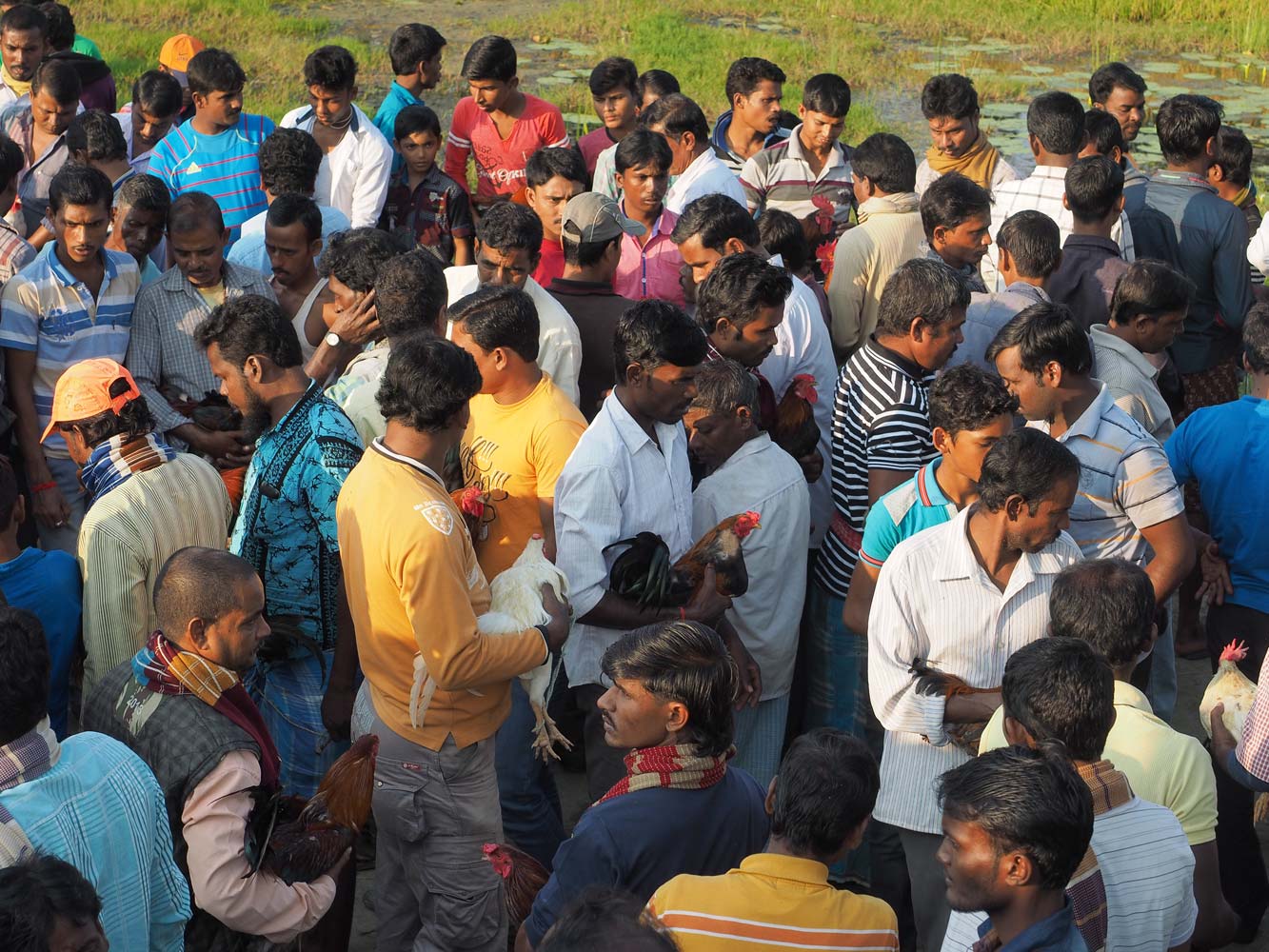
Men gather with
their roosters.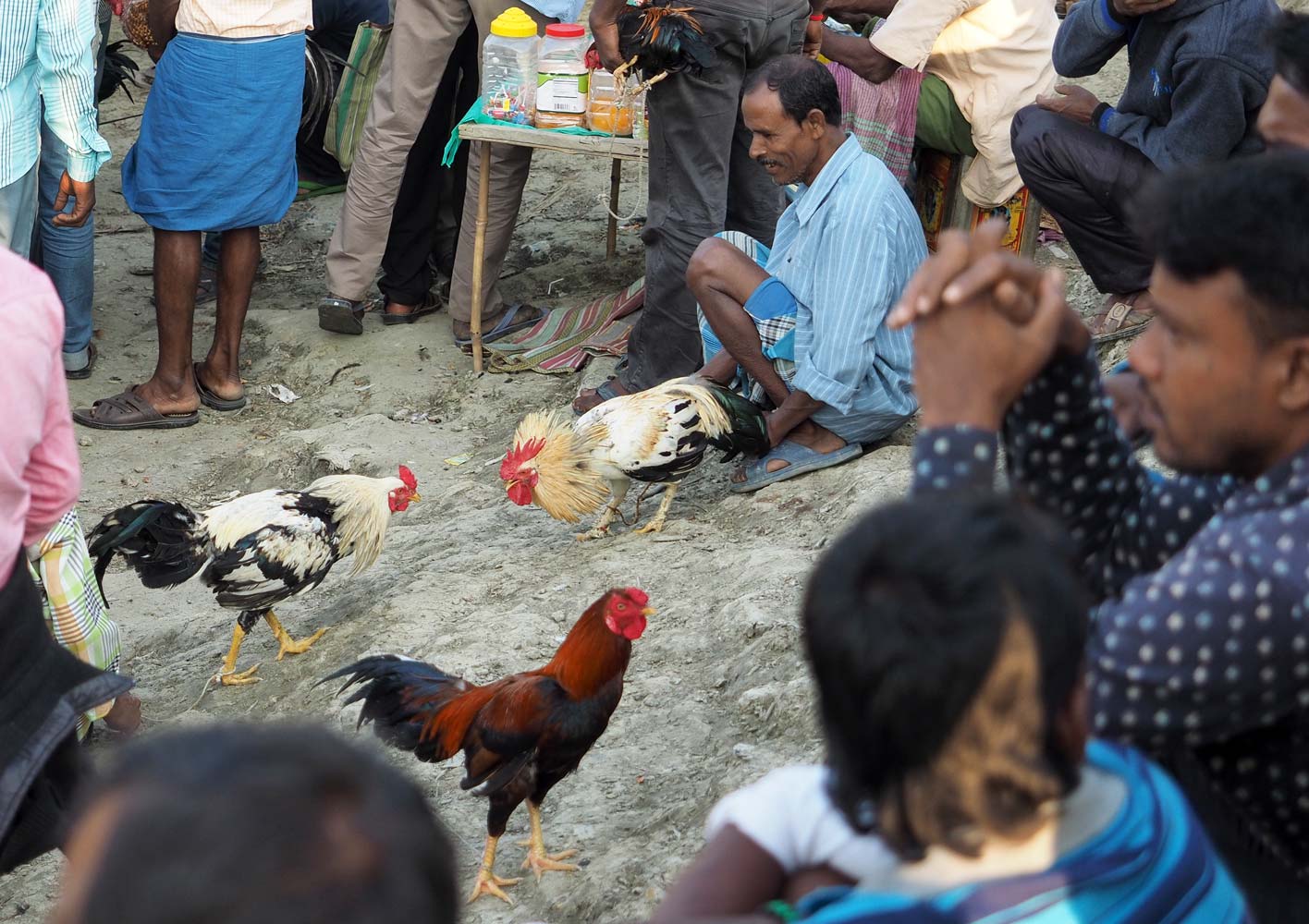
A pair of roosters size each other up.
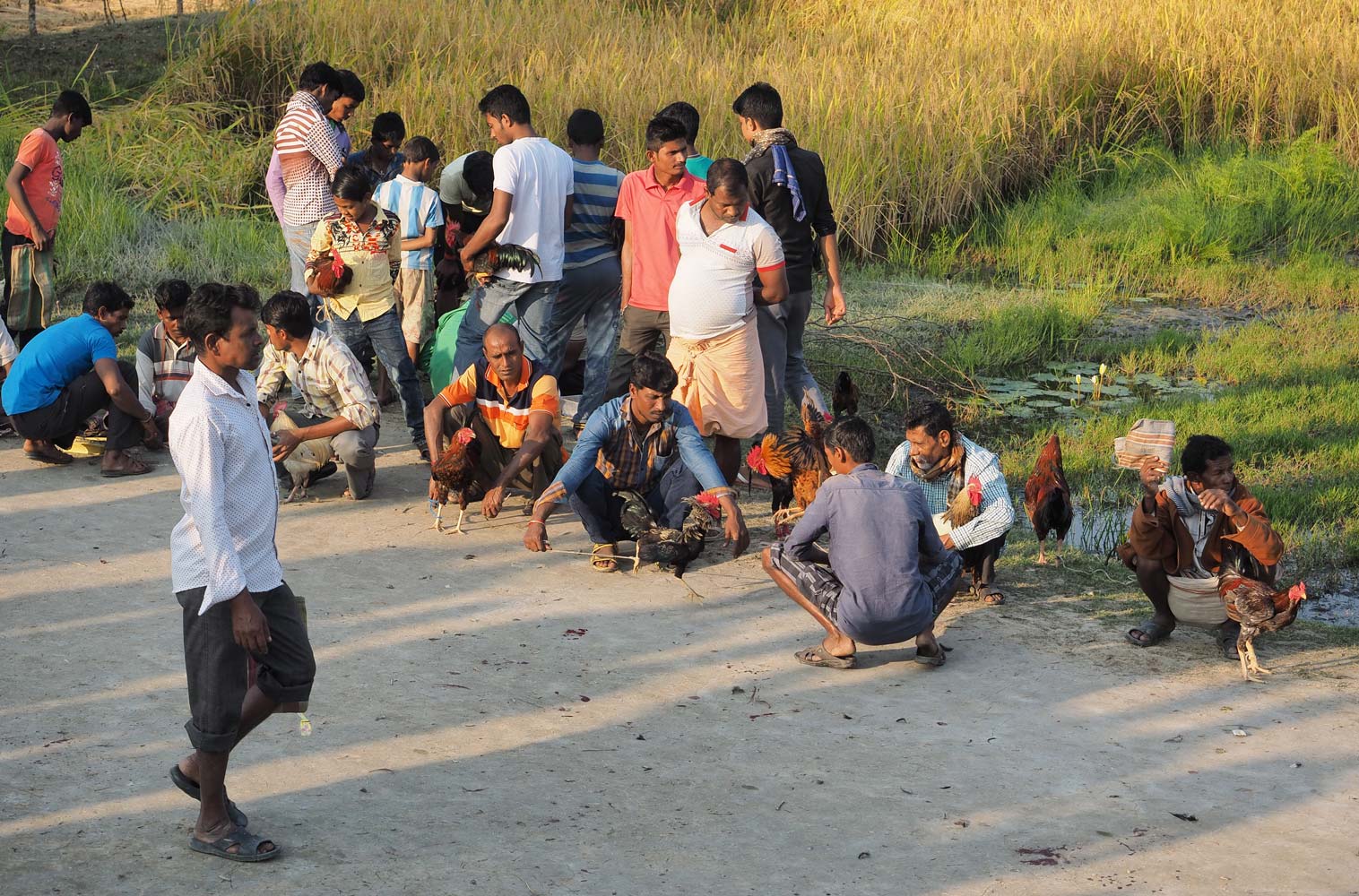
Men talk shop.
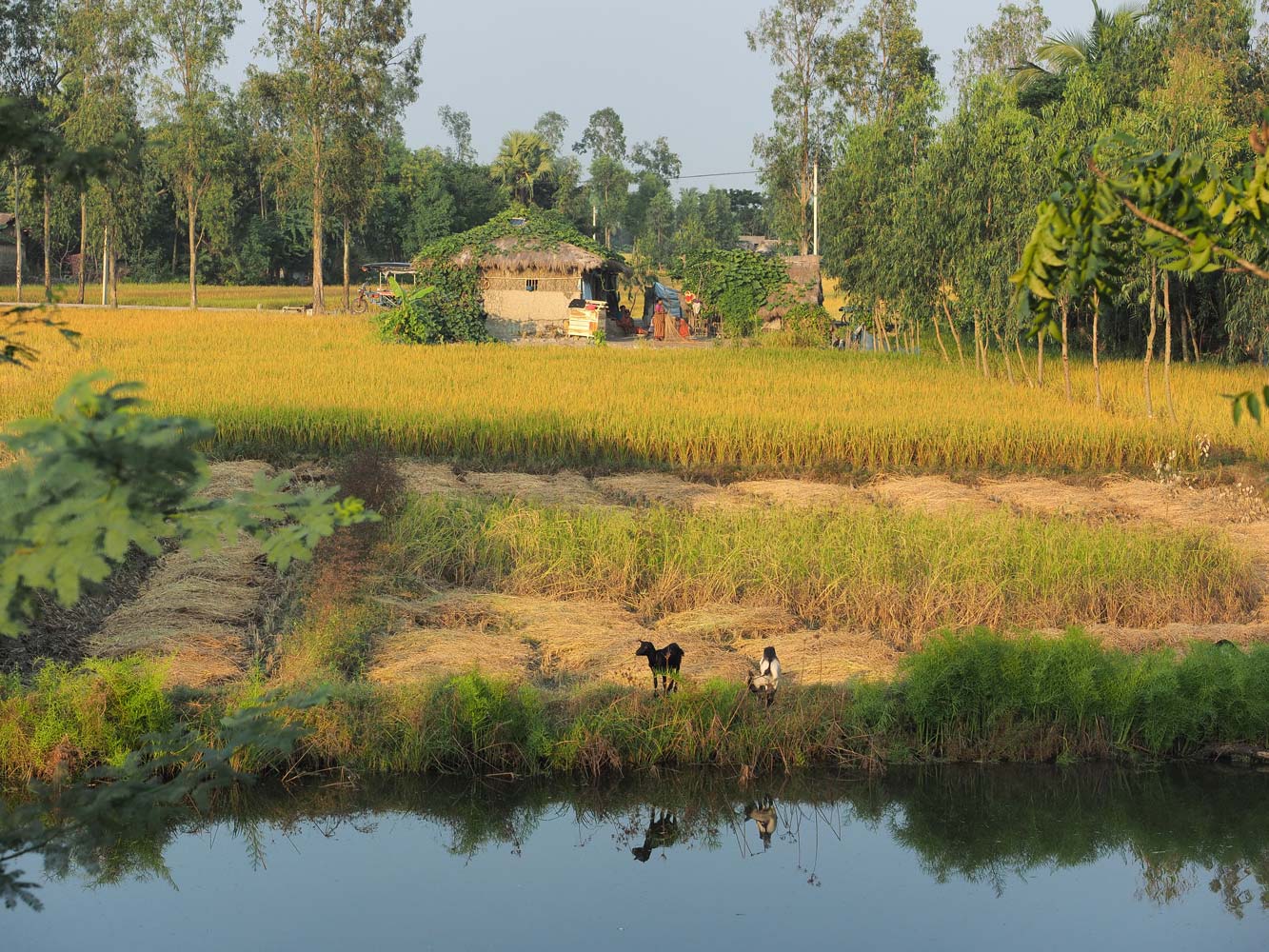
Village rice
fields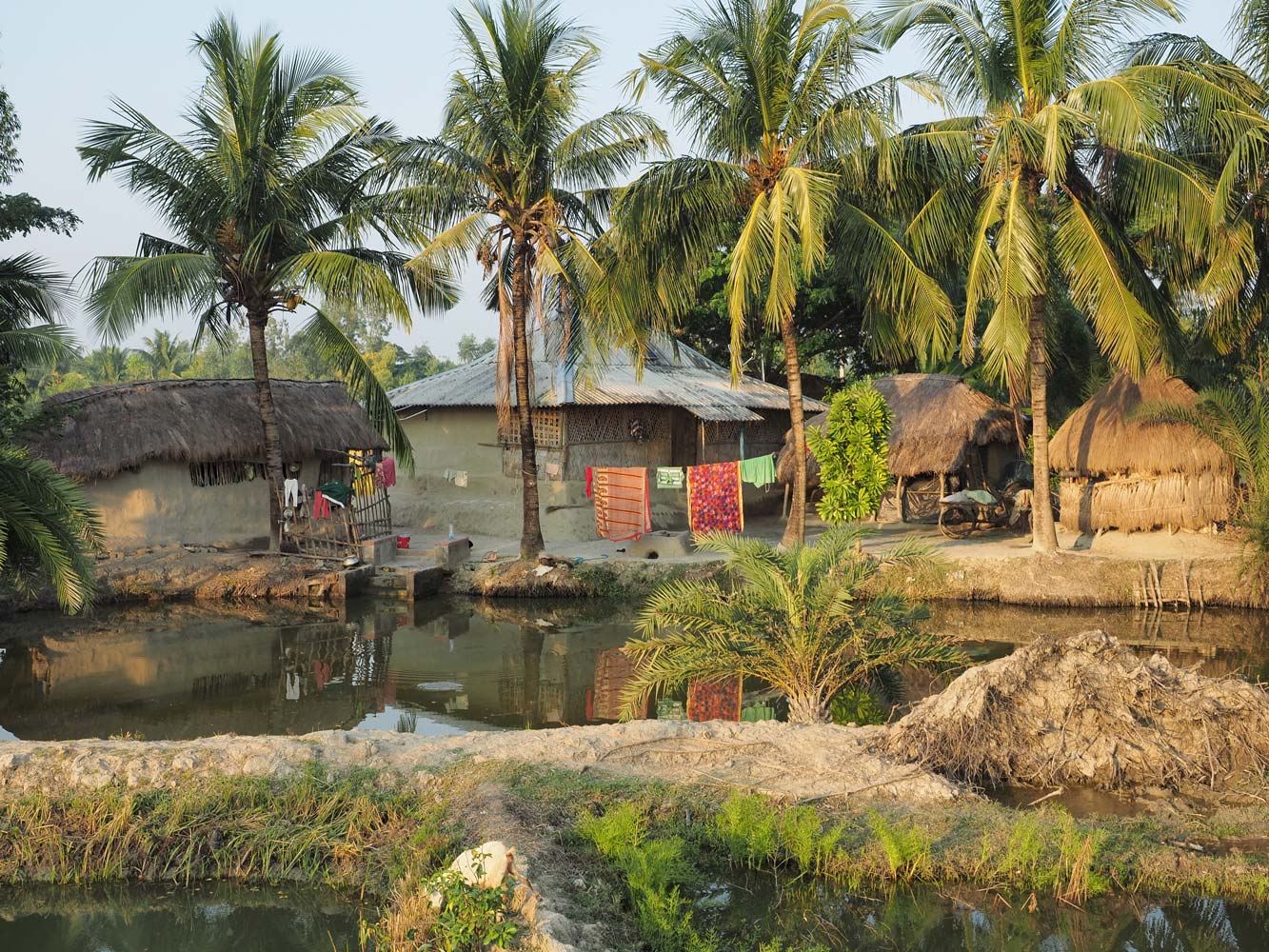
Village life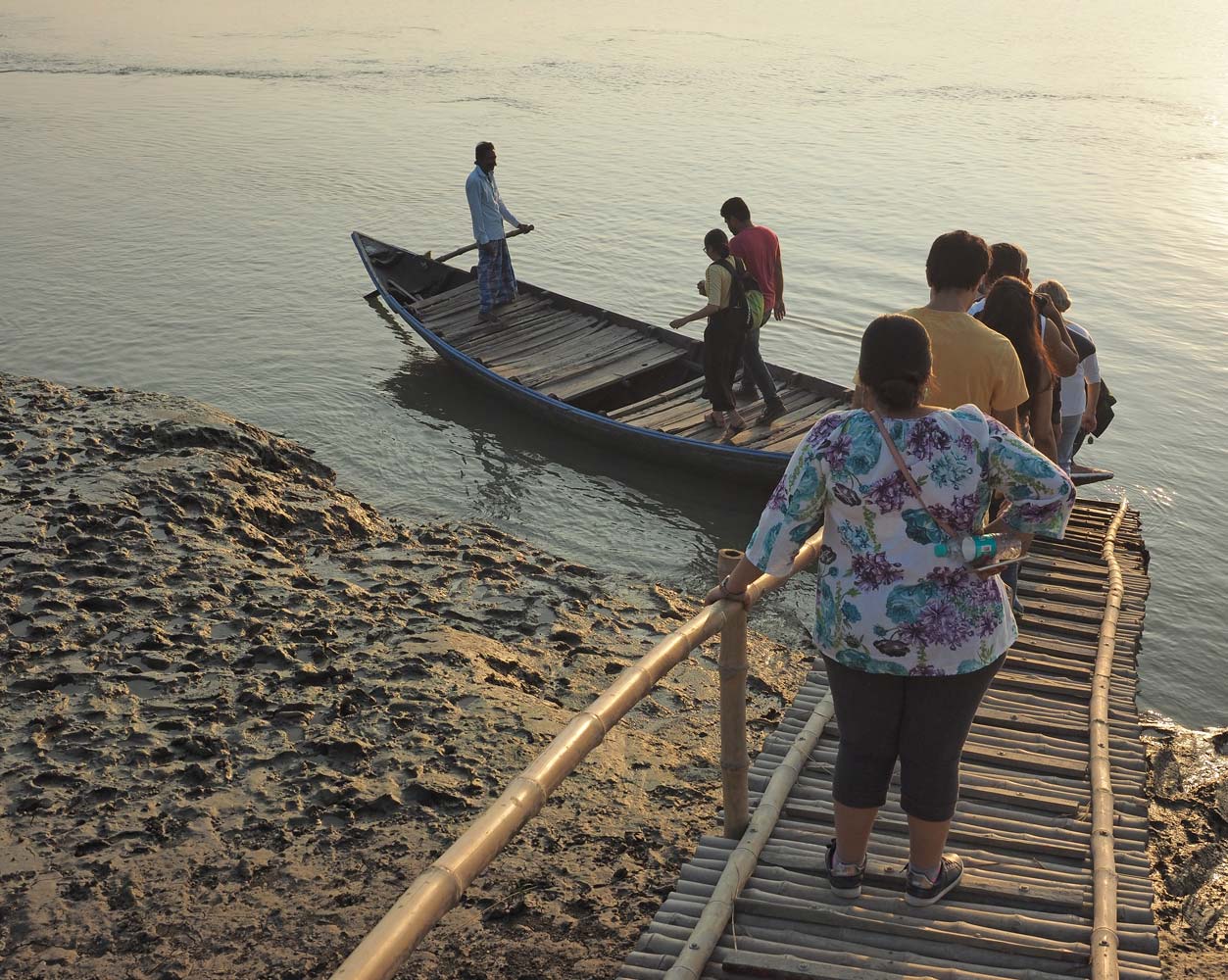
We board our little boat for a mangrove cruise.
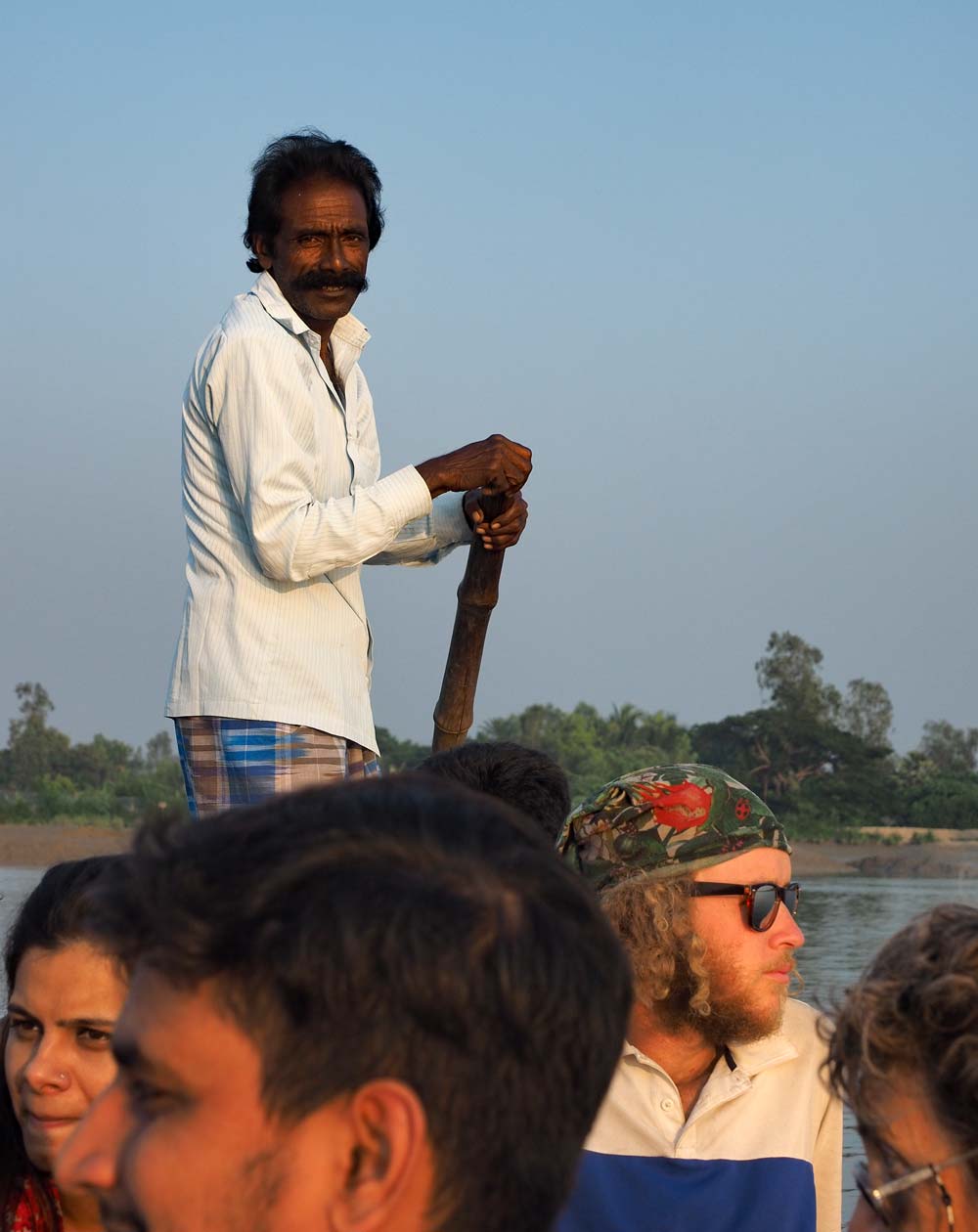
Our captain
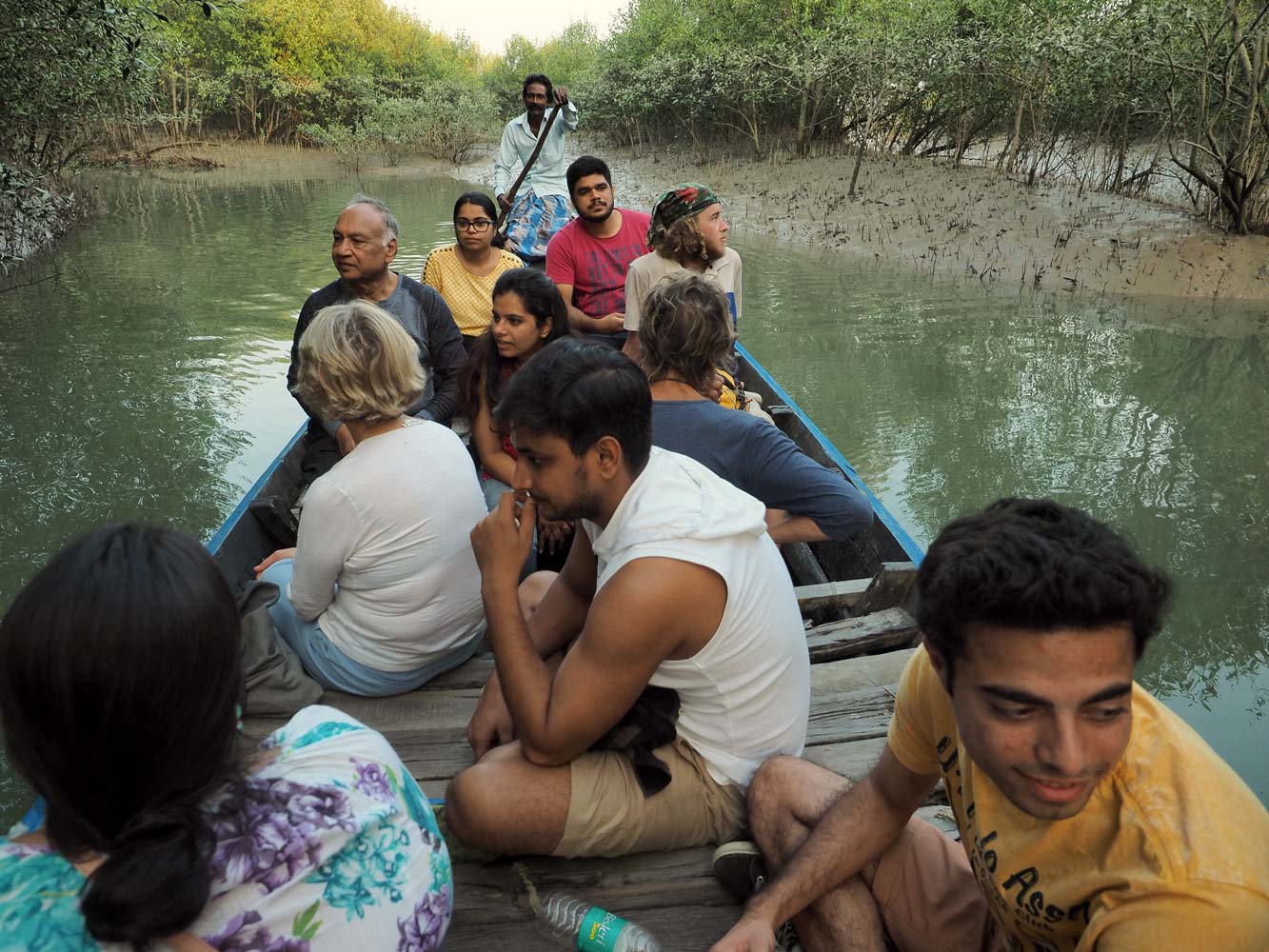
Exploring the
mangroves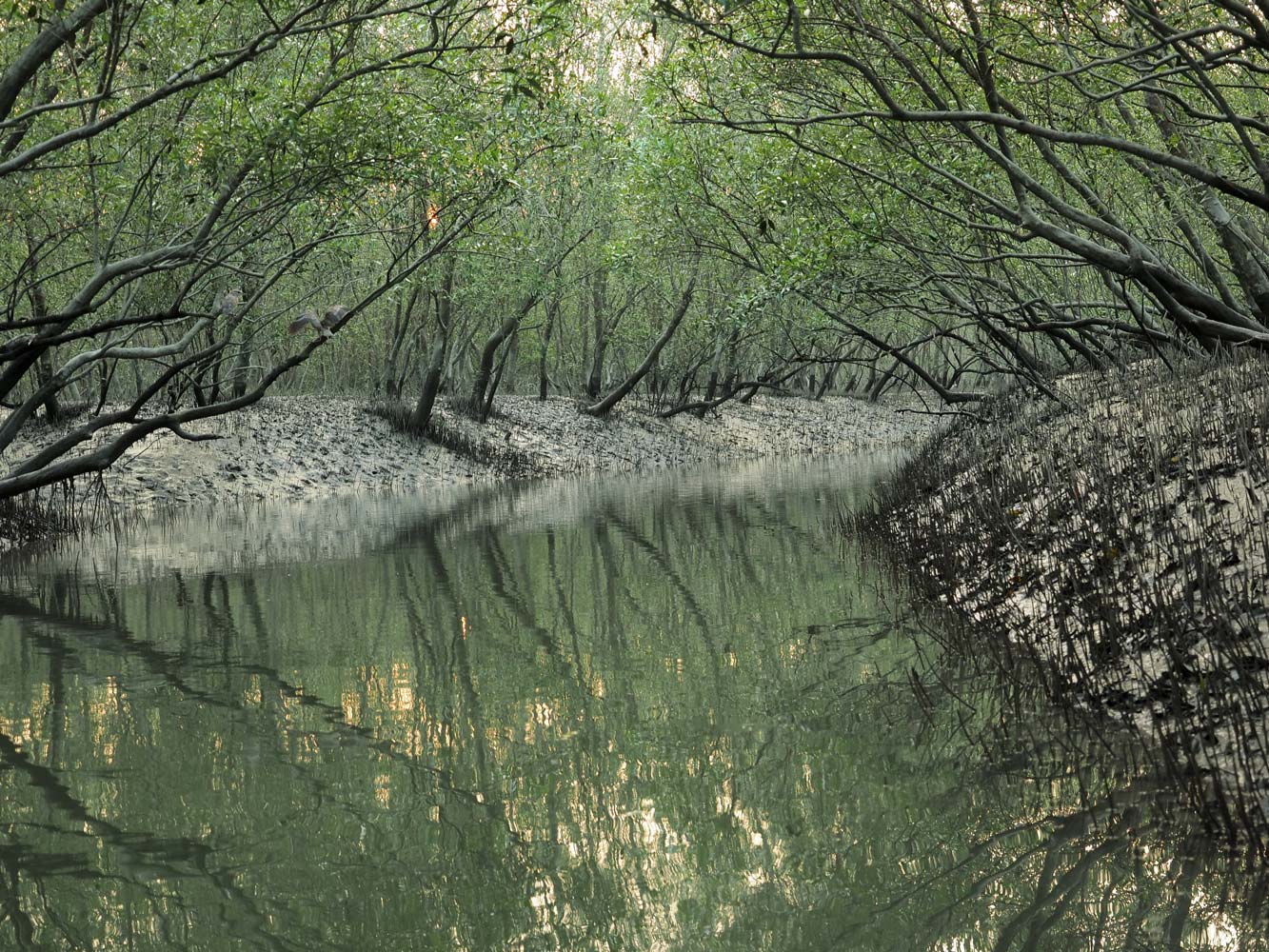
A
couple little herons perch on the left.
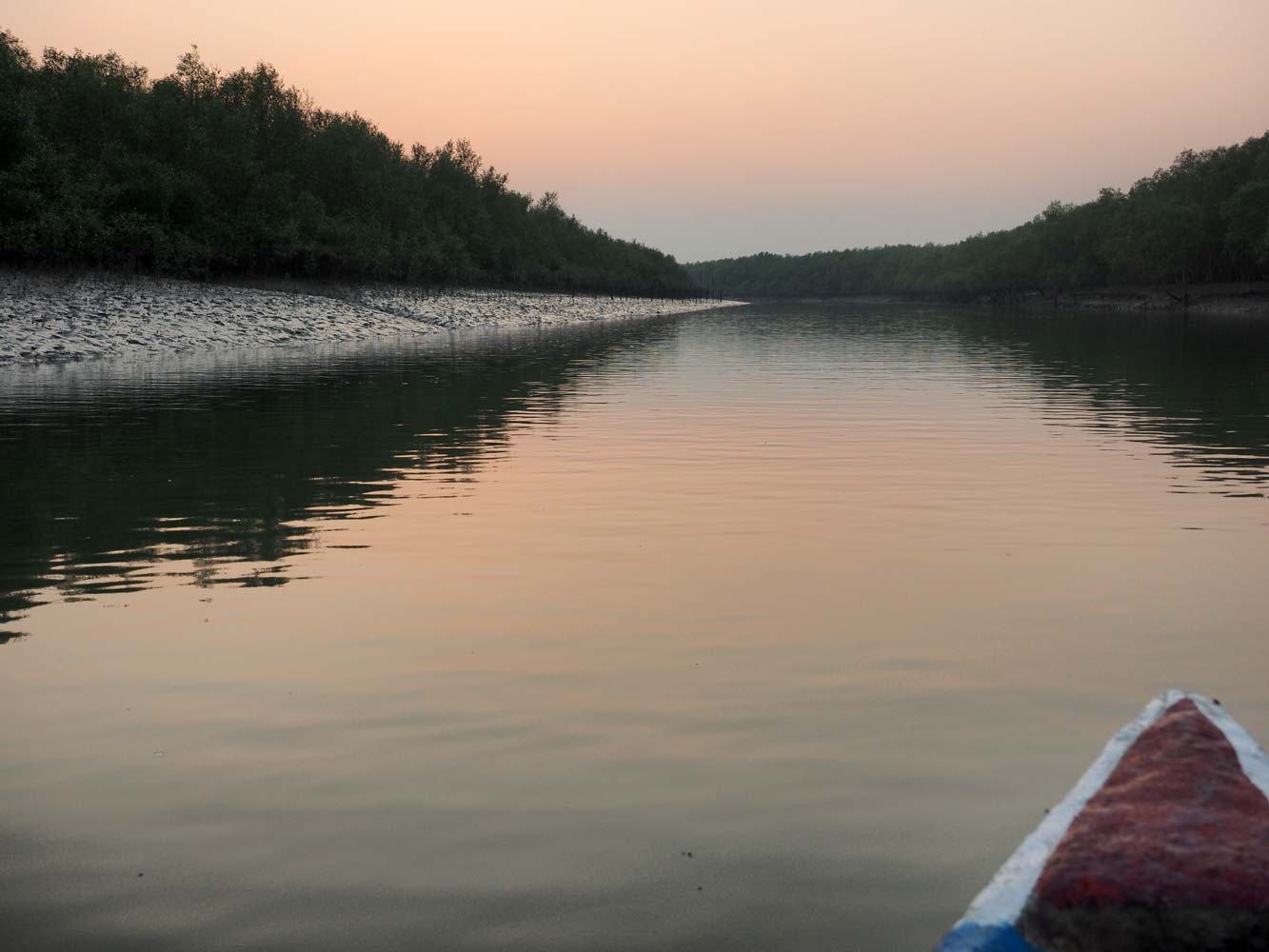
The sun departs and
we head home.
We returned to our eco village as the last light faded from the sky. Village musicians
sang and played their drums and harmonium for us before dinner. Food was very tasty
with a variety of vegetable curries. Although my room with its attached bath looked
good on first glance, I had bad luck with neighbors—a very chatty and loud couple
on one side and party types who came home in the middle of the night on the other.
The upper walls between us are merely woven bamboo, so there’s nothing to stop the
noise. I slept poorly, not daring to use earplugs and miss the early morning departure
of the boat tour.
25 Nov. Sunderbans
We got off about 6:30 a.m.
on our Sunderbans tour boat, patterned like all the others here with an enclosed
lower deck for the crew and a shaded open-sided upper deck for passengers. We first
had to stop at a village on the other side of the river to fill plastic jugs with
fuel, then crossed to the park office for paperwork, all handled by the crew. Rhesus
macaques (Macaca mulatta) foraged on the muddy banks, and it turned out they were
looking for bits of discarded vegetables that had washed down from villages far
upriver. We began a very satisfying all-day loop through channels large and
small among mangrove-covered islands. From the unseen kitchen on the lower deck
emerged a breakfast of poori (puffed fried bread) and vegetables for breakfast,
then a full lunch of vegetable curries. Glasses of tea appeared frequently.
A park guide joined us, and both he and our tour company guide were very enthusiastic
and helpful in pointing out and telling us of the wildlife we saw. The mangroves
comprise many species of trees and a palm, all in slightly different hues of green.
Of course what everyone wished to see were tigers! It’s likely a royal Bengal tiger
(Panthera tigris tigris) saw us, but we only spotted tracks at two crossings where a
tiger had come down a beach, swum across the river, then up the other shore. A large
group of smooth Indian otters (Lutra perspicilatta) scampered along the mangroves,
surprising our guides because these animals are a rare sight. We saw many chital
(Axis axis), also known as axis or spotted deer, which keep their spots into adulthood. Most hung out in
small groups or a mother with baby. A solitary Indian wild boar (Sus scrofa) stood
on a shore. We began seeing estuarine crocodiles (Crocodilus porosus) swimming in
the rivers, then later in the morning we saw them sunning on the shores. Although
fish remained unseen in the muddy rivers, the birds knew where to find them. We
go to see a Brahminy kite, a lesser adjutant stork, kingfishers, and lots of common sandpipers.
In the afternoon we got off the boat at two watchtowers, Dubanki and Sudhanyakhali,
not so much to see wildlife as to stretch our legs. At the second site we saw a
kill site of a deer killed by a tiger. Only blood spots
and impressions in the mud marked the struggle. As the sun sunk into the hazy horizon,
we headed home. Most of the group had signed up for the two-day tour, and would
be making the long trek back to Kolkata in the dark. Myself and the solo Indian
tourist transferred to another tour boat for the ride back to the eco village and
another good dinner. We enjoyed a very quiet and restful night!
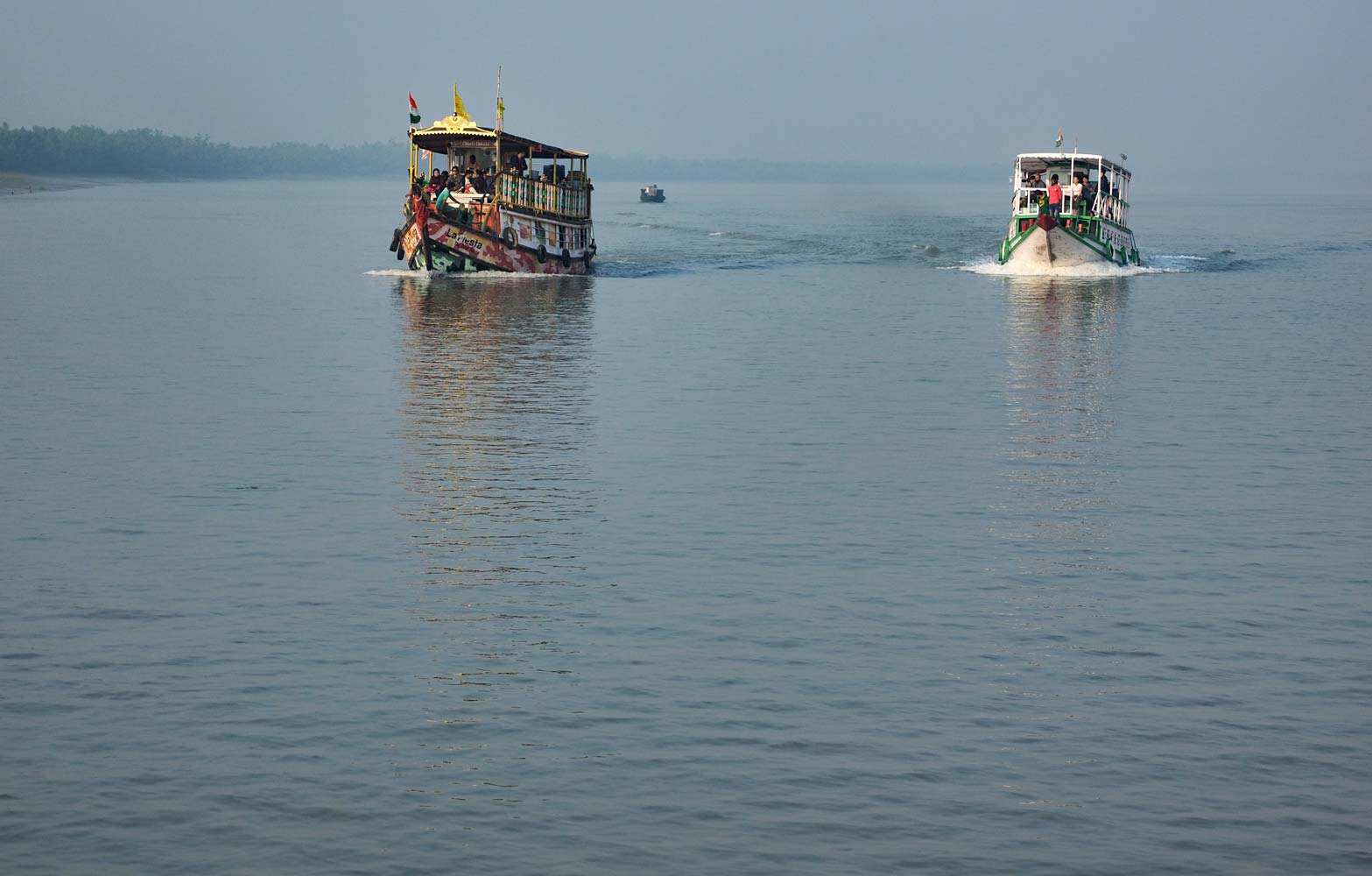
A pair of tour
boats similar to ours begins their day.
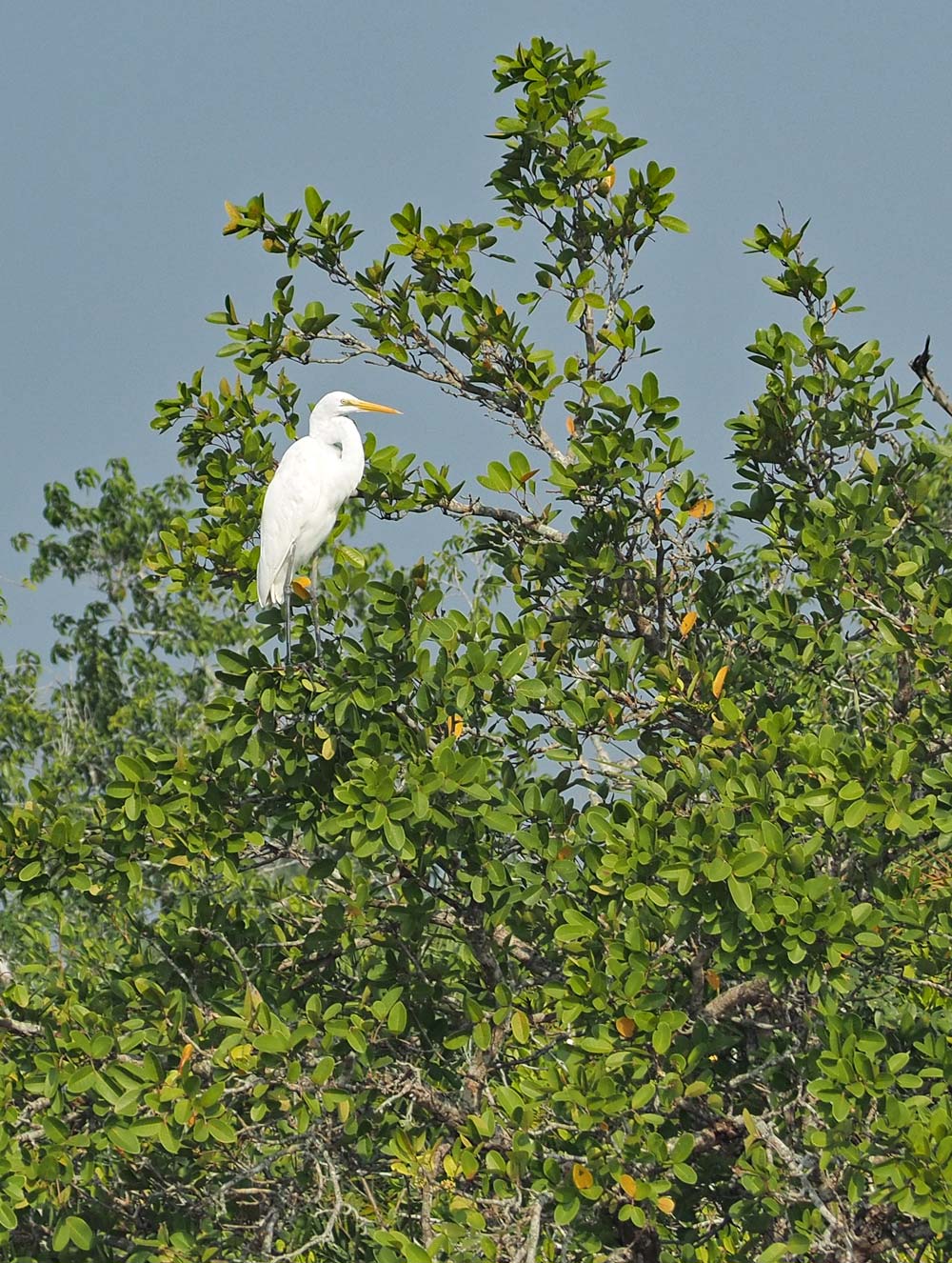
A cattle egret
(Bubulcus ibis), a species of heron, keeps watch.
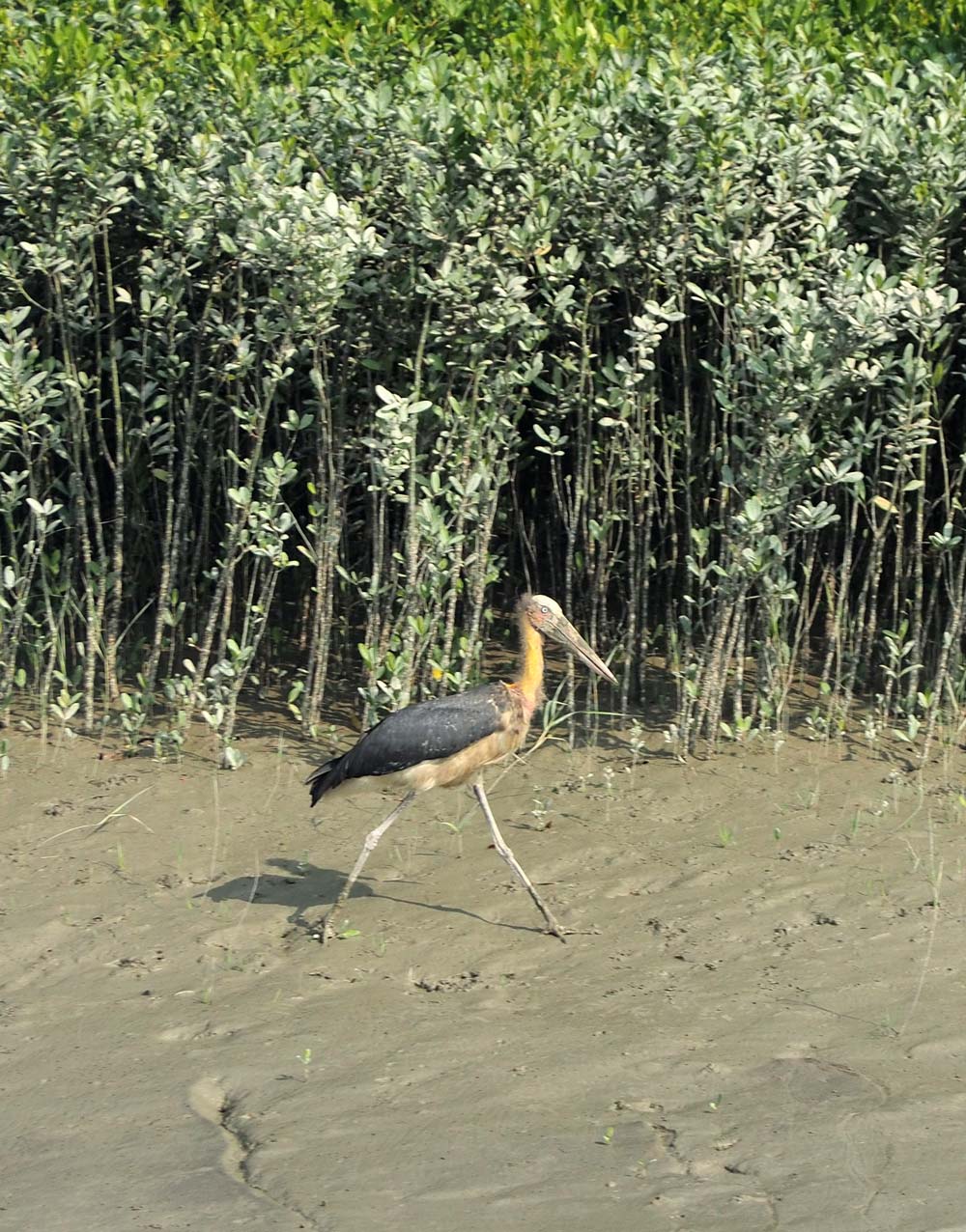
The lesser
adjutant (Leptoptilos javanicus) is a large wading bird in
the stork family Ciconiidae.
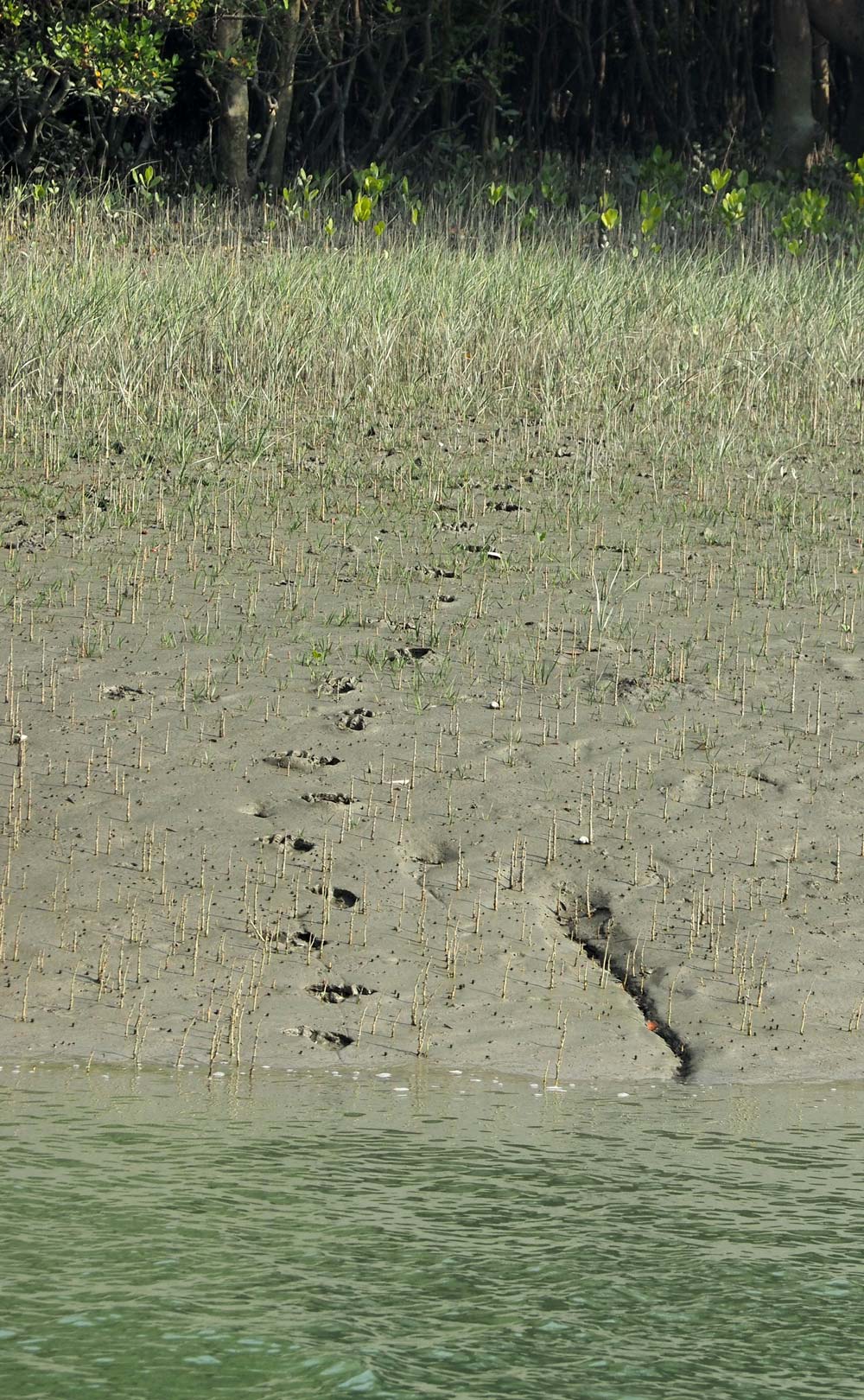
Tiger track!
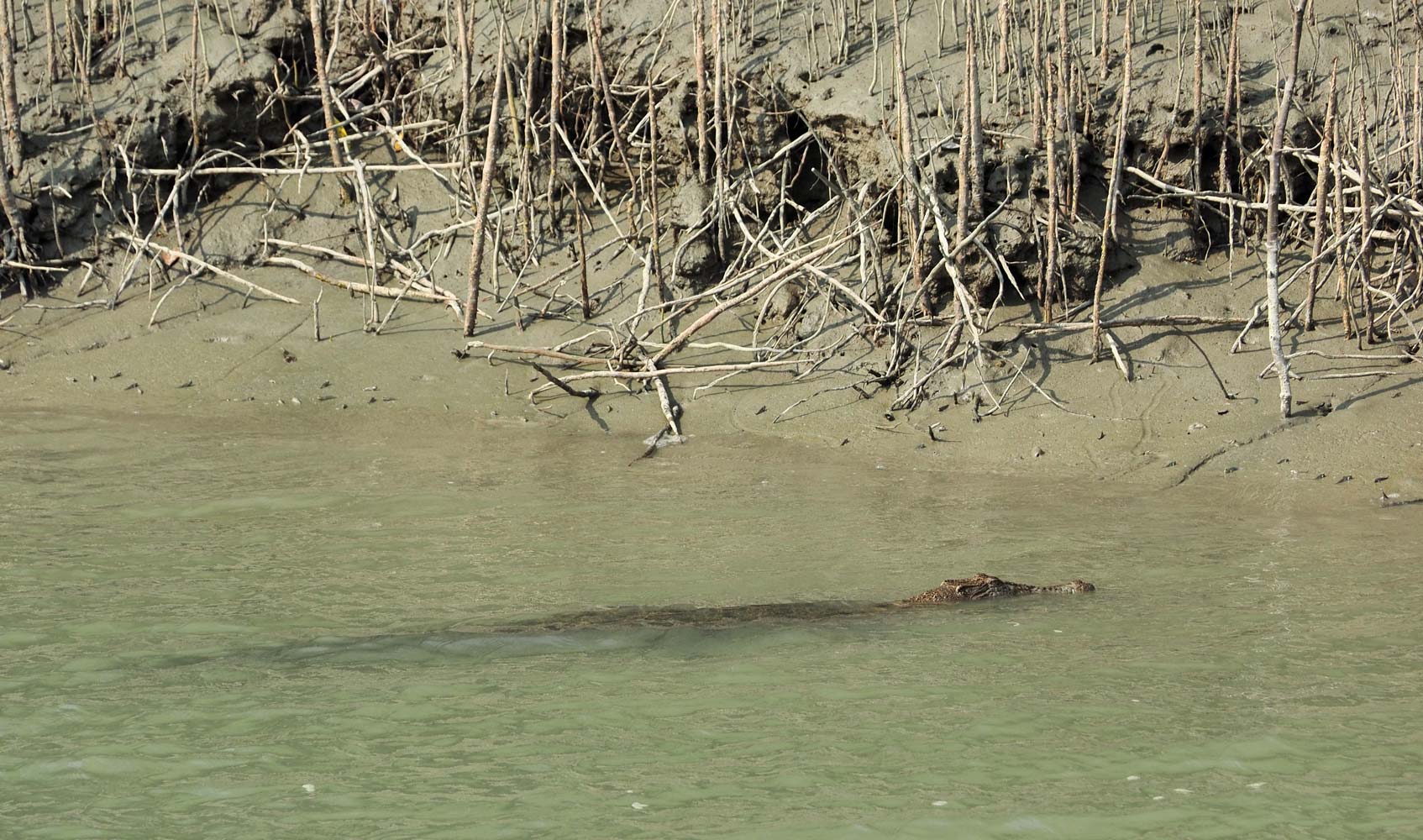
Does this ‘log’
have eyes? 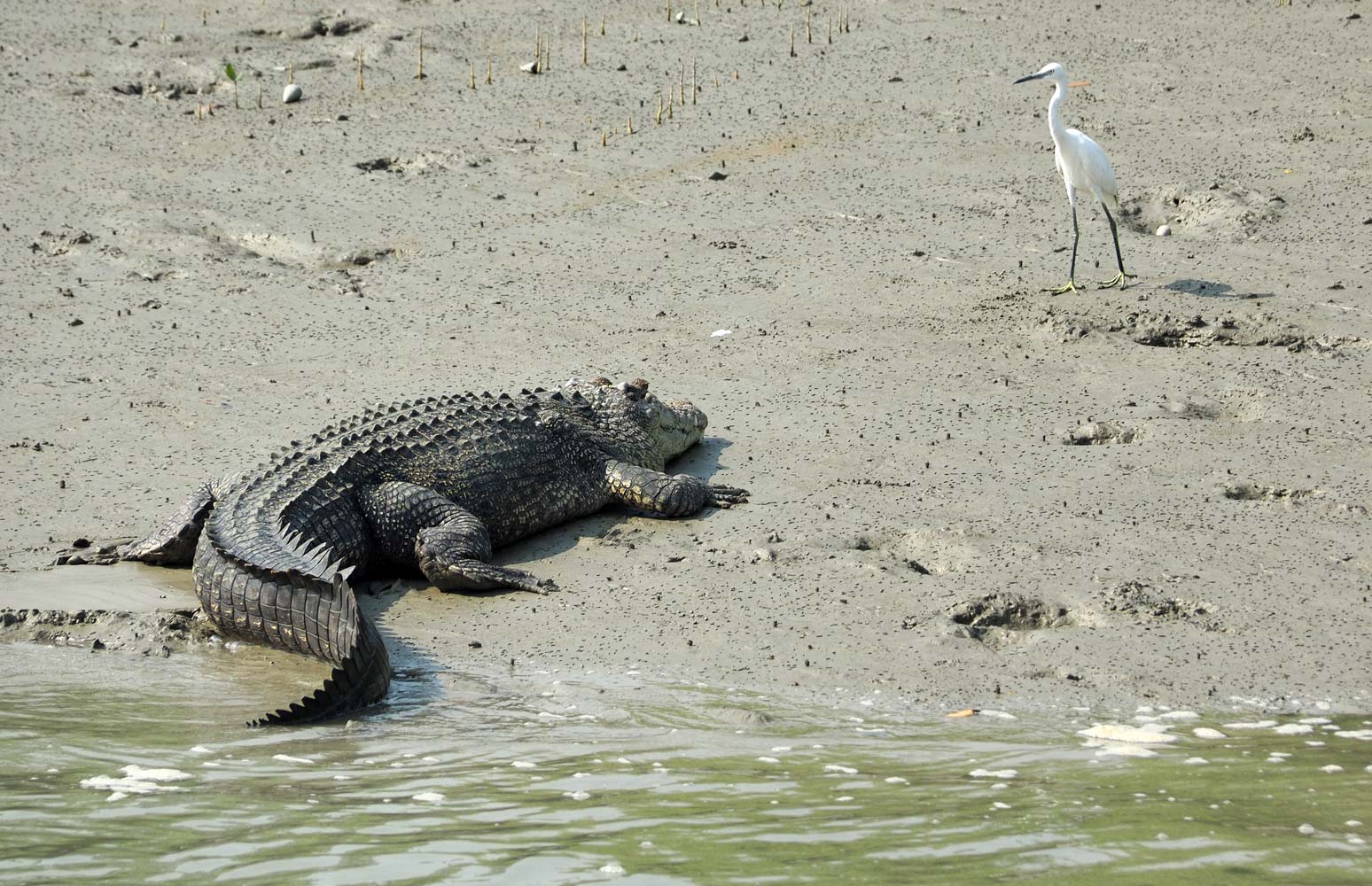
Estuarine crocodile (Crocodilus porosus) with a cattle egret
(Bubulcus ibis)
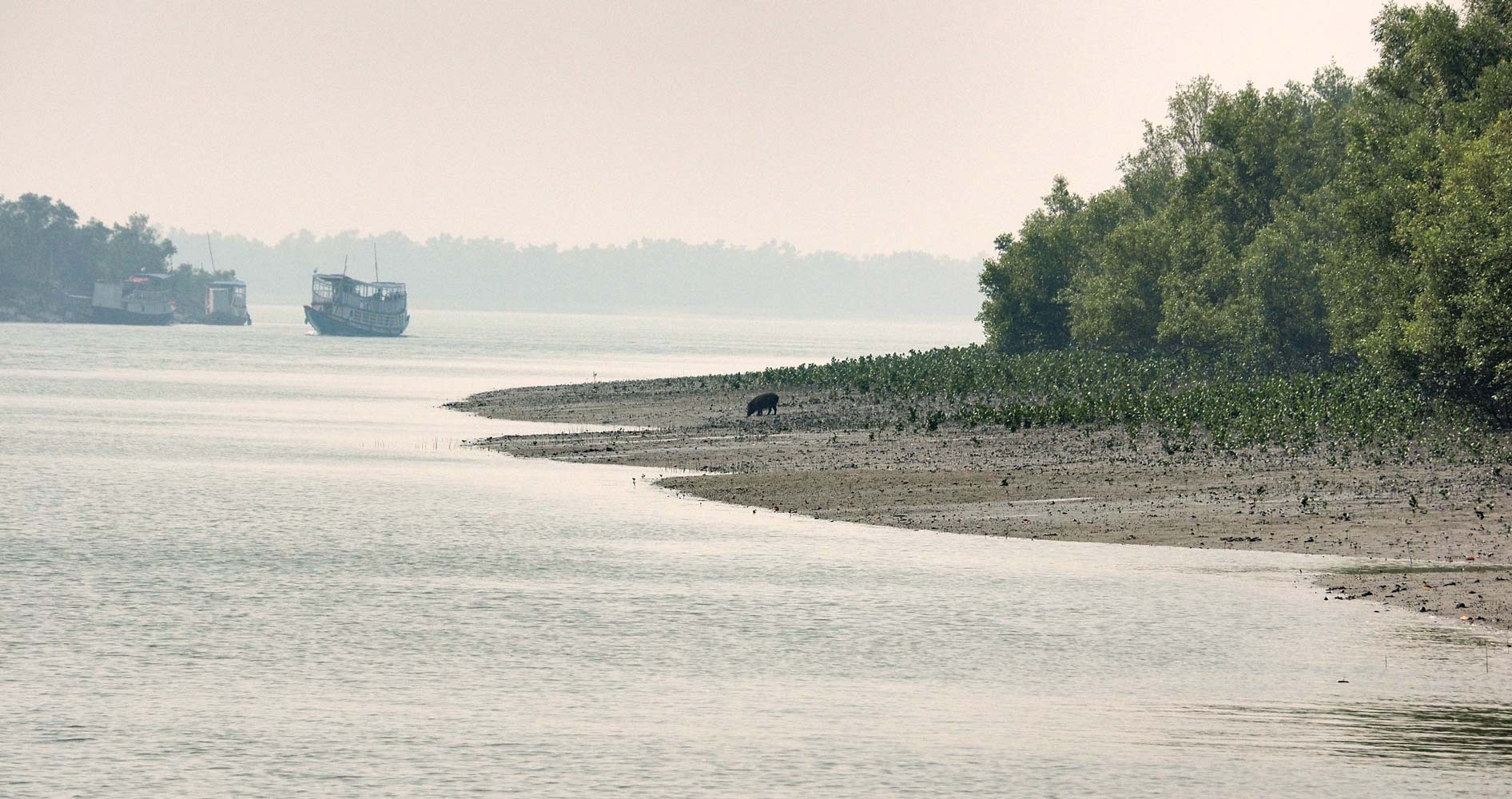
An Indian wild boar
(Sus scrofa) comes
out in search of food.
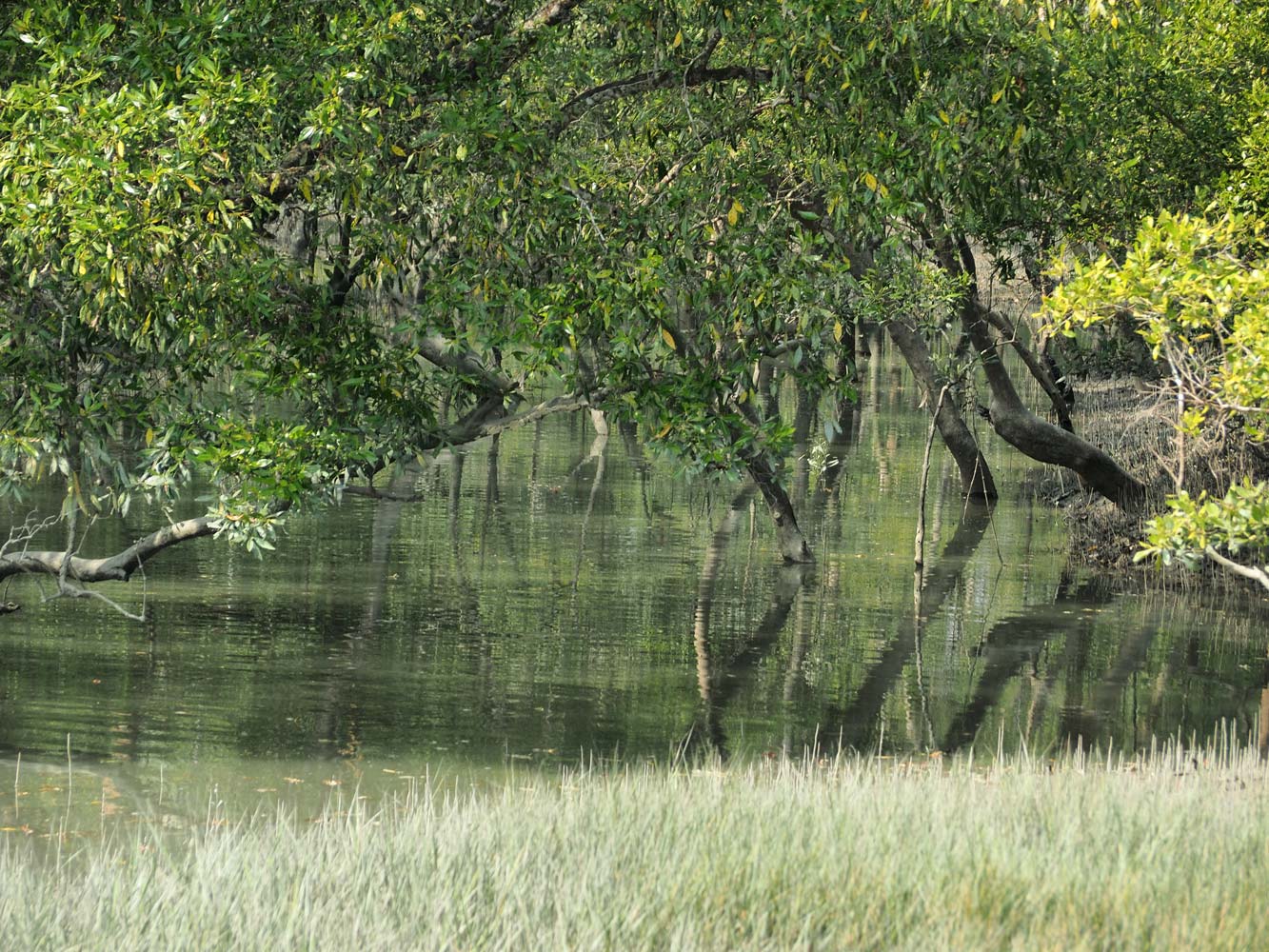
A view into the
mangroves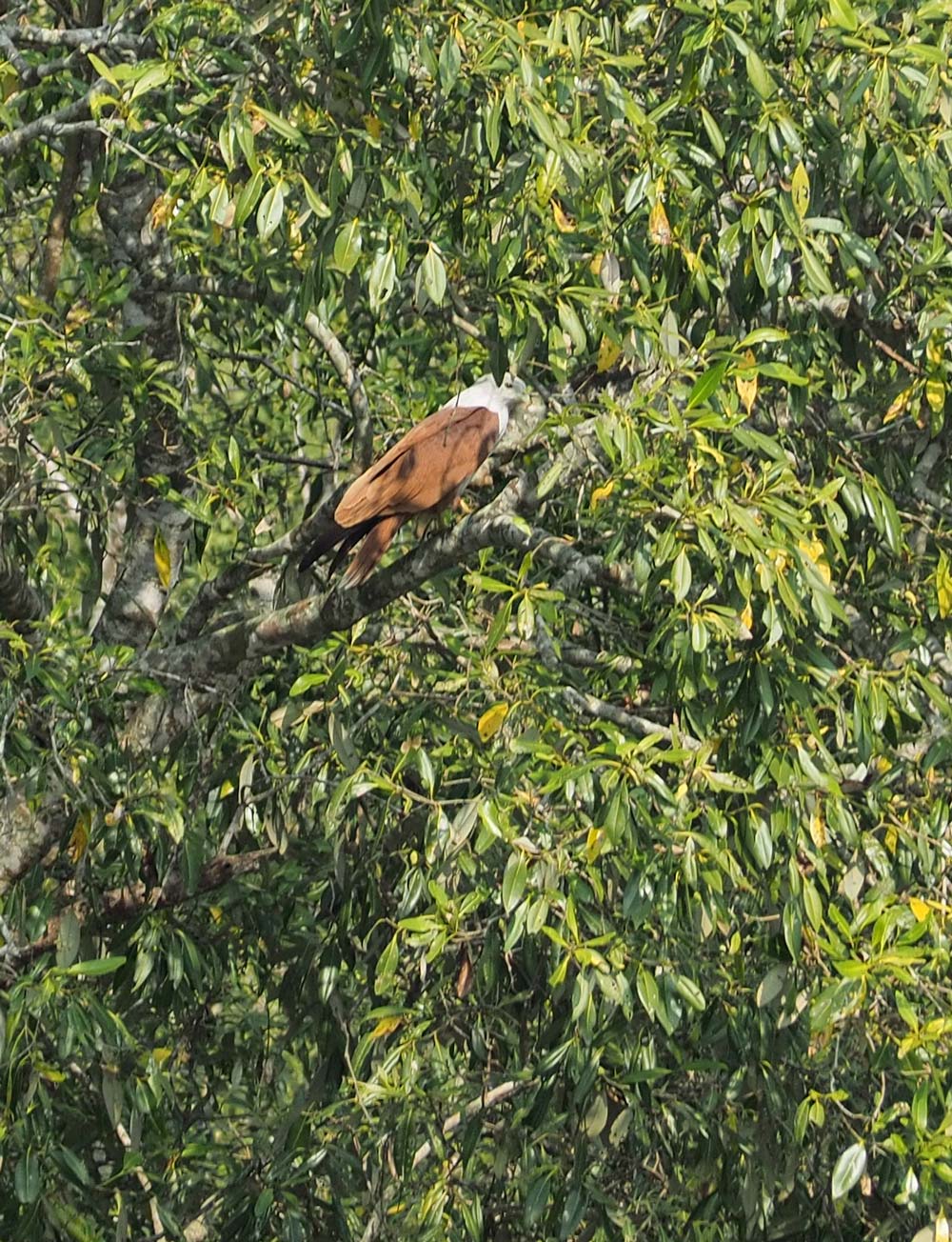
The Brahminy Kite (Haliastur indus) takes its name from the Brahmin
caste of India.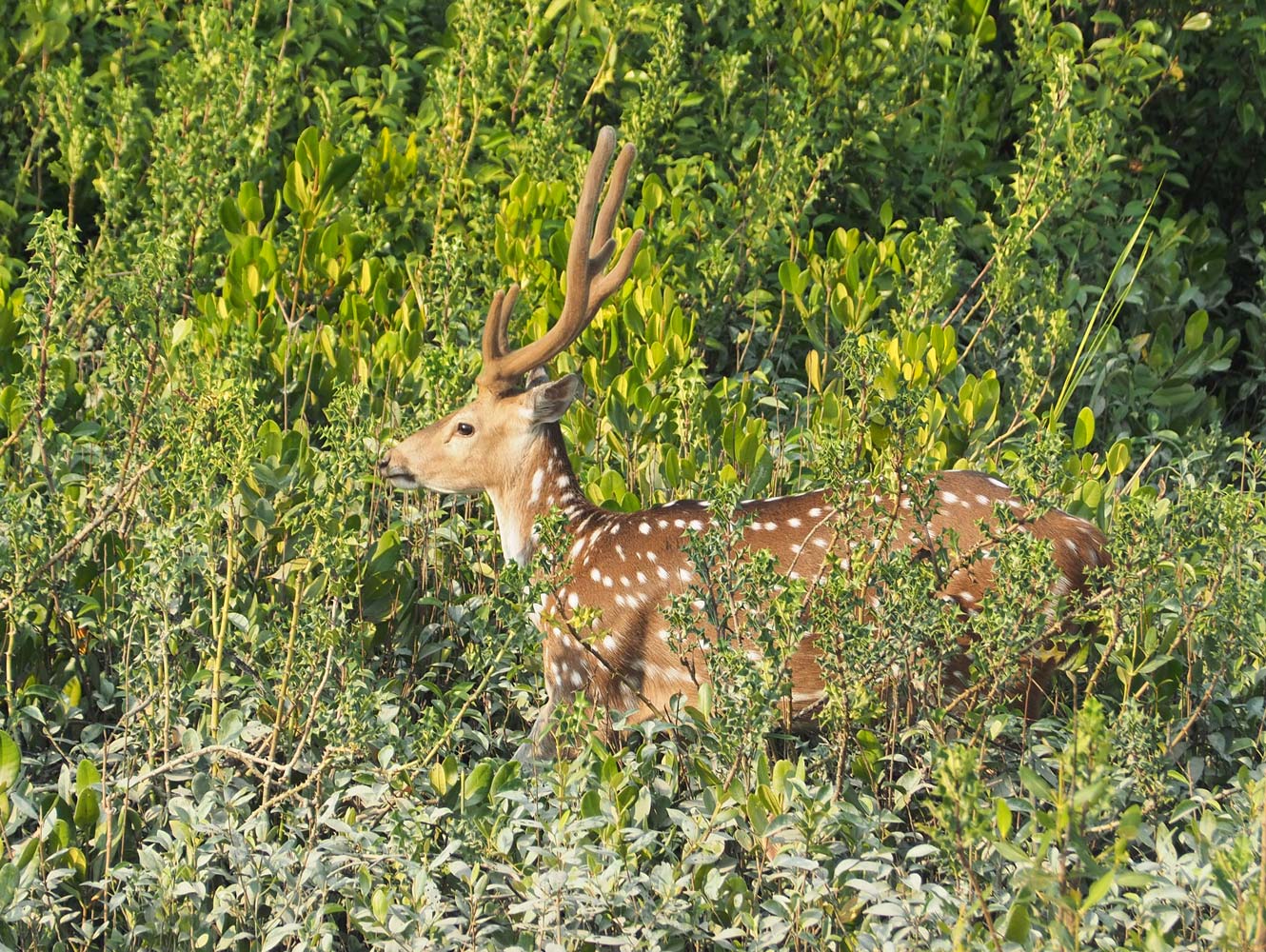
Chital (Axis axis); only the males have antlers.
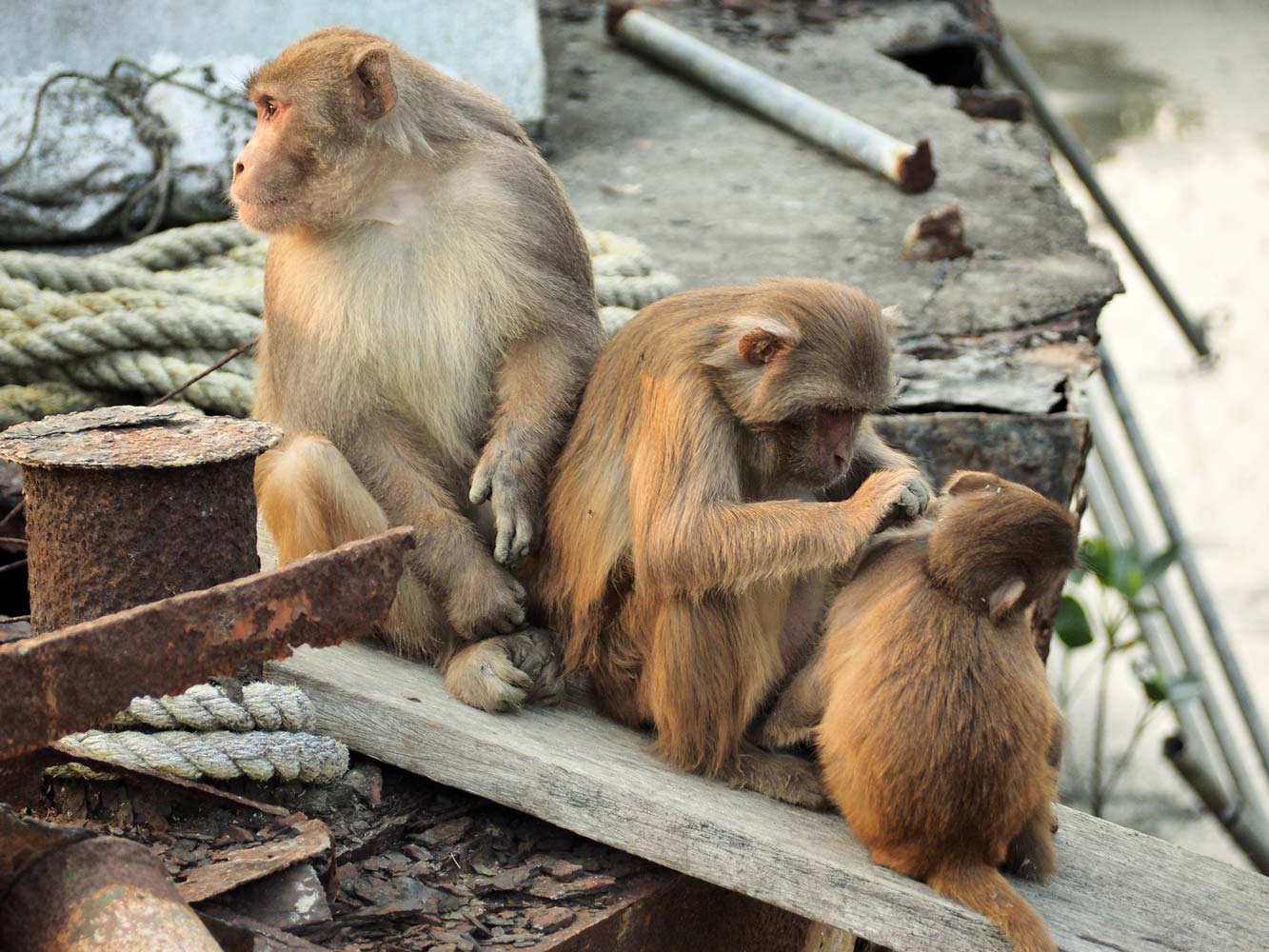
Grooming time for a
family of rhesus macaques (Macaca mulatta)
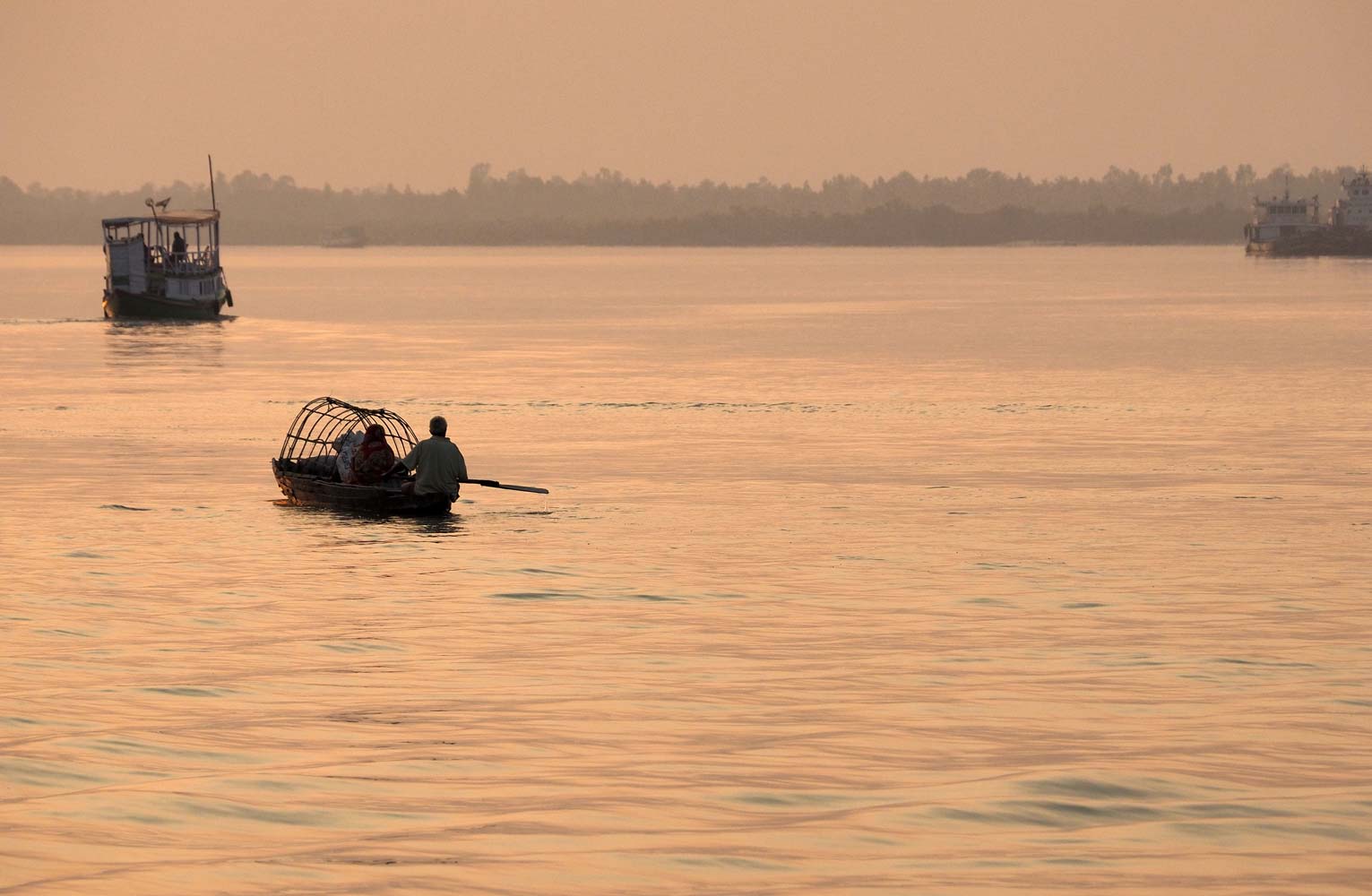
Sky and water turn
to gold in late afternoon.
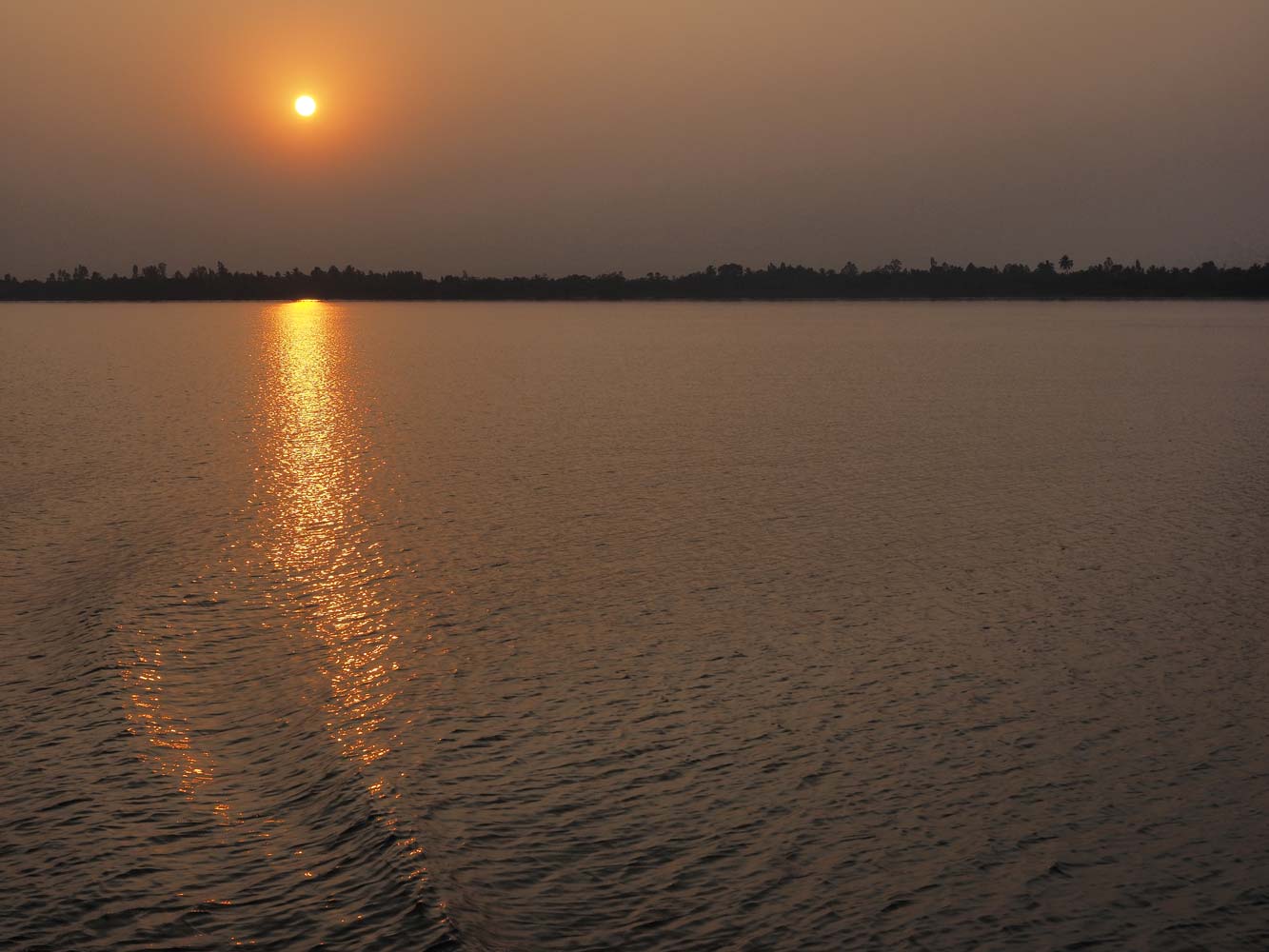
A long and
enjoyable day in the Sunderbans comes to an end.
26
Nov. Kolkata
Although the morning didn’t have any scheduled activities, after
breakfast one of the tour company’s brothers took us around the large island on
an electric autorickshaw to see village life, rice fields, and two areas of water
lilies. One of the villagers then accompanied myself and the Indian tourist on a
flat-topped ferry boat across the river and the three-wheeler across the island
to the next ferry. We had to wait awhile at the road head for transport to get sorted
out, then got on a tour bus for the long 106-kilometer grind back to central Kolkata.
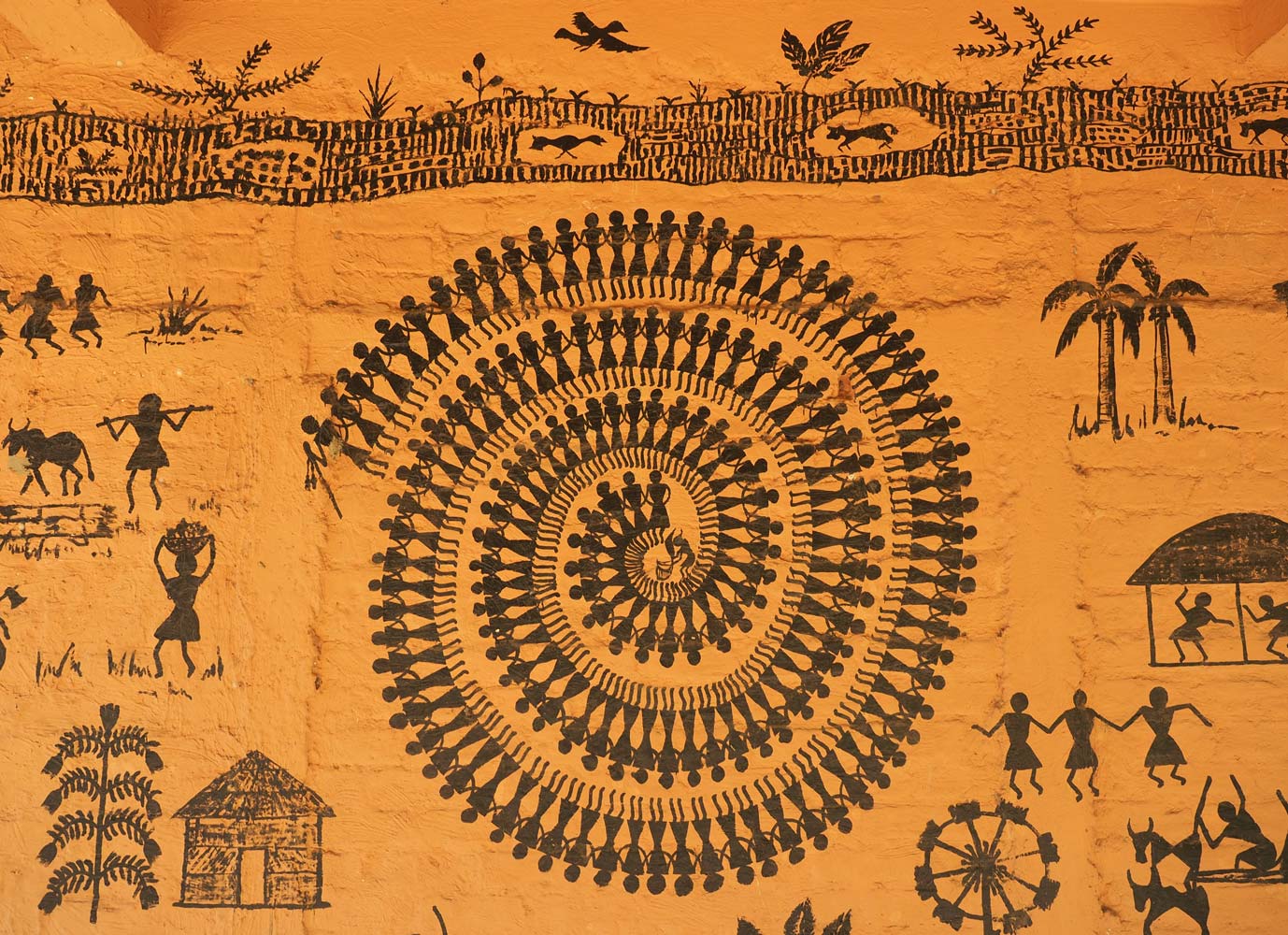
Village artwork
on a wall in our resort in the Sunderbans
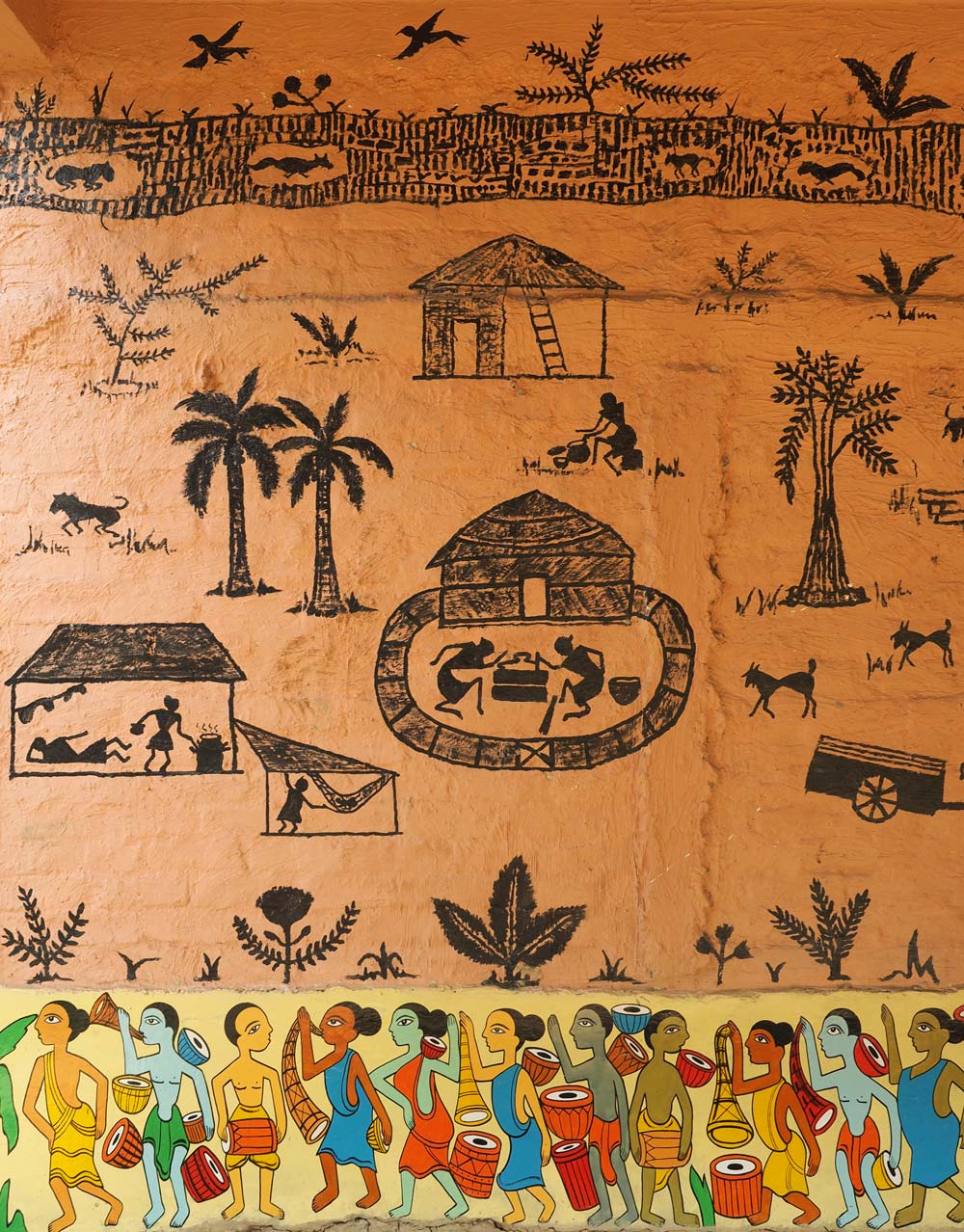
Another scene of
village life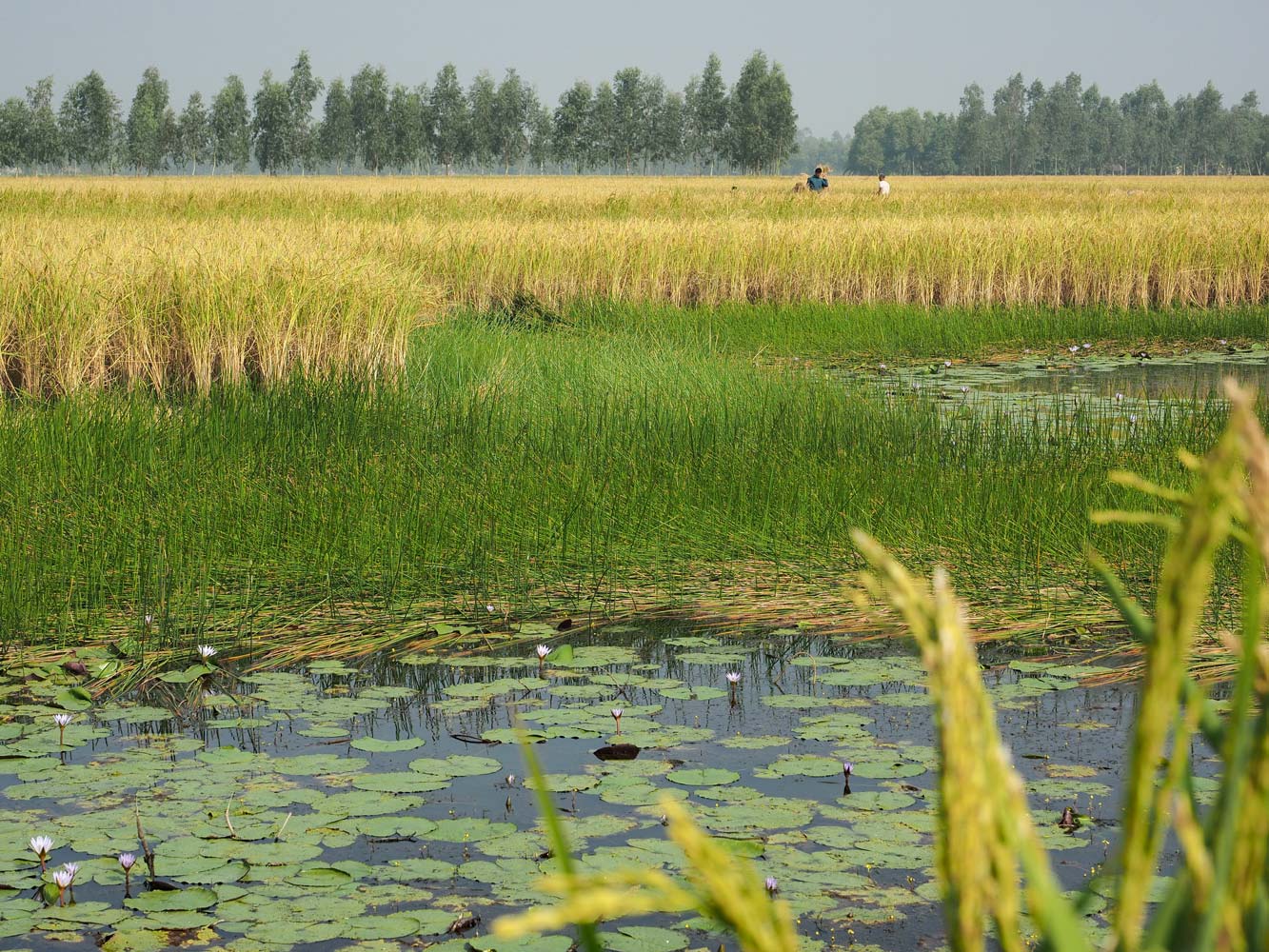
Village rice fields beside a pond of water lilies
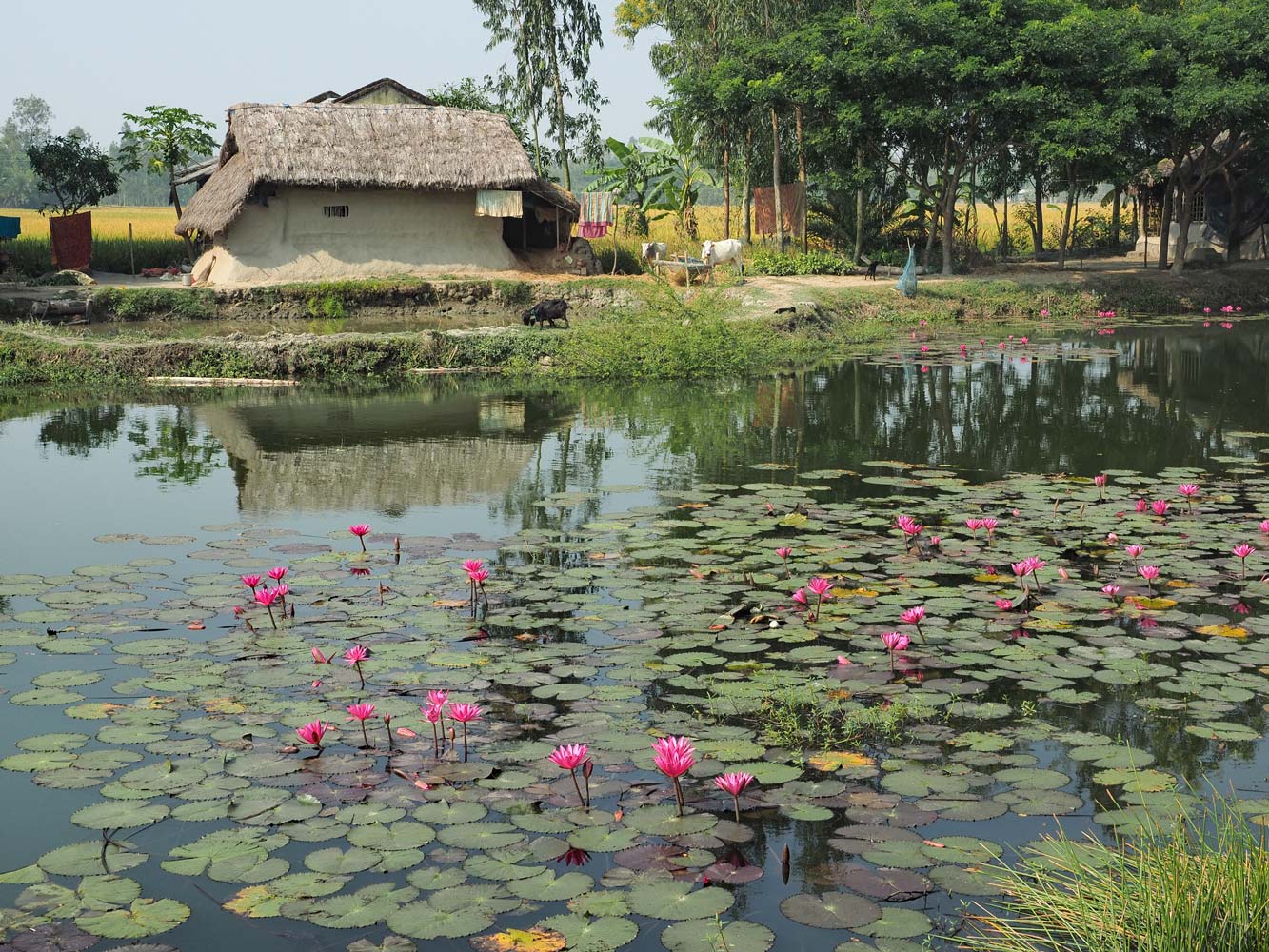
Village water
lilies
Kolkata Backpackers didn’t have a vacancy for the final four nights of my
Kolkata stay, so I had reserved a single room through booking.com
at Georgian Inn (1A
Doctor Lane), mentioned in the Lonely Planet guide as a ‘backpacker guesthouse.’
Cost of the four nights was 5,000 rupees + 600 rupees tax, though I didn’t have
to pay anything in advance. Unfortunately when I was in the Sunderbans the Georgian
Inn sent an e-mail requesting payment to a bank account within 24 hours, then cancelled
the reservation when this didn’t happen. When I got back to Kolkata, I phoned the
Inn and was told I could have a double room (999 rupees) tonight, then move into
a single room for 100 rupees less on the following three nights. It’s in the Talitala
Market area, a bit over a kilometer northeast of Sudder Street, so I walked over.
The room was on the noisy side, but it had a little table, hot water, and good wi-fi.
Oddly I stayed in the same room yet still got the 100-rupee discount
on the last three nights. The location isn’t the best, and perhaps I should have
tried more hotels in the more convenient Sudder Street area, but those I did check
didn’t have vacancies.
I got a taxi through the slow
thick traffic south to Elgin Road and the Akhra, a small cultural center where I
sat in an outdoor theater for a concert of folk music by two groups, one with a
female soloist and the other with a male singer. The songs were very pretty even
though I didn’t understand the words, which I assumed were Bengali. Afterward I
wandered to nearby Kewpies, a long-running Bengali restaurant, and ordered the special
vegetarian thali. Besides the standard items, I could choose three items from the
vegetarian menu, and went with banana flowers (mochar tarkari), gram flower cakes
in tomato sauce (dhokar dalna), and spinach-wrapped cottage cheese balls in coconut
gravy (palong channar kofta). All the dishes, served in little clay bowls, proved
very tasty yet unlike the more common North Indian cuisine.
27 Nov. Kolkata
Today I mostly hung out in my room and surfed the internet. In
late afternoon I caught a taxi for a ride south to the ICCR/Rabindranath Tagore
Centre, where a different group show of paintings had just opened. Then in the auditorium
I watched a fast-paced dance and music program from Zimbabwe by the Hwamanda Dance
Troupe. Part of the group of men and women would dance while the others beat drums
and chanted, then some would trade places for the next performance. The dances reflected
village life with thoughts for rain, celebrating the harvest, and of youth when
boys and girls get together.
28 Nov. Kolkata
I strolled over to
Blue Sky Café for a good breakfast, then continued on foot to Victoria Memorial
Hall, a very beautiful domed structure of white marble. Lord Curzon, Viceroy of
British India, proposed the memorial to Queen Victoria in 1901 and it opened twenty
years later. Indians feel less sentimental toward the long-ago monarch, of
course. Exhibits
inside offer an illustrated history of Kolkata from its founding by the British
to the Bengali cultural awakening and finally the modern city. Other rooms have
wonderful paintings and prints of India from past centuries. Queen Victoria still
‘reigns’ in her youth under the rotunda and in old age on a throne outside in front.
A series of 12 paintings inside the dome depict major events of her long life as
queen. A temporary exhibit by Swayam, a Kolkata-based feminist organization, had
an exhibit “Voices of Courage and Sorrow, Women in the Dark Speak Out” about finding
refuge from domestic violence faced by Indian women. Lastly I walked around the
exterior to admire the architectural details and the 16-foot high, 3-ton bronze
Angel of Victory statue atop the dome.
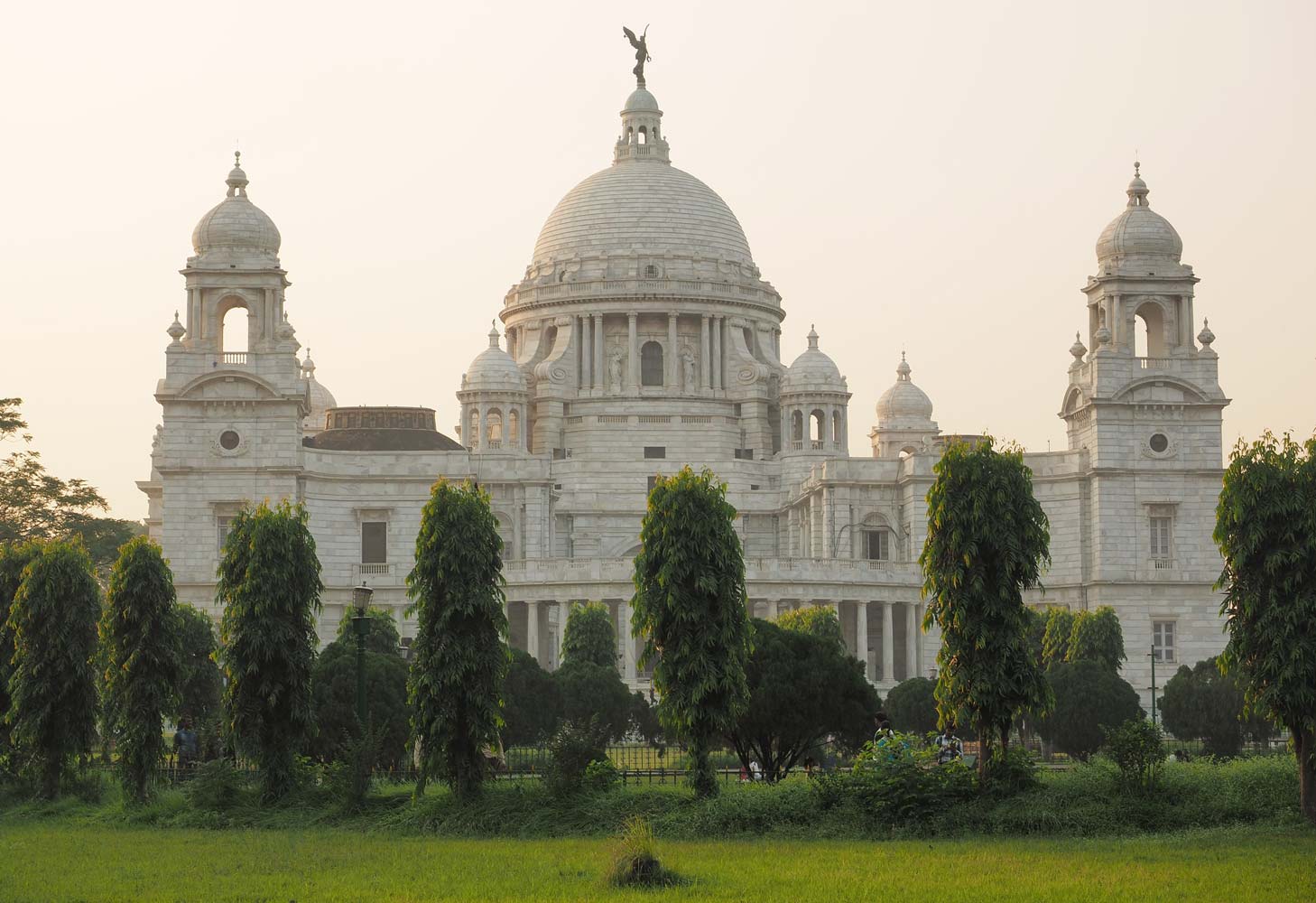
Victoria Memorial
Hall (back side) in late afternoon light
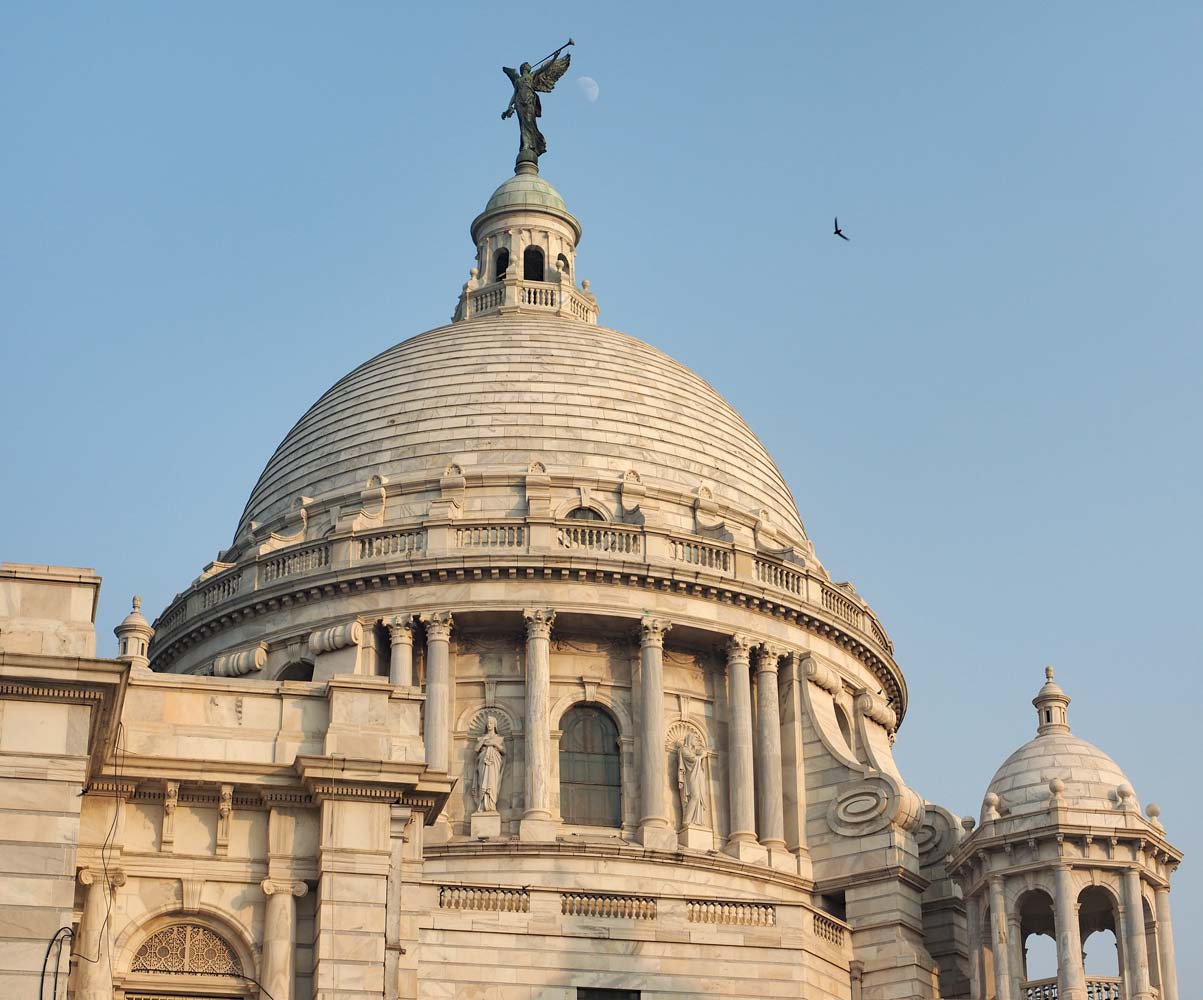
The Angel of
Victory tops the central dome.
A path led out the east side
of the park-like grounds to a busy street, where I crossed to the Nandan-Rabindra
Sadan Complex to see an excellent group show of paintings, photos, and sculpture
at the Academy of Fine Arts. Another busy street crossing to the east led to Haldiram
and a super tasty vegetarian thali.
29 Nov. Kolkata
Breakfast at
Blue Sky Café again, then I headed over to the nearby Indian Museum
https://indianmuseumkolkata.org/.
It’s the oldest and largest in the country, established in 1814 and now housed in
a grand 1875 white building that wraps around a grassy courtyard. On my previous
visit to Kolkata four years ago the museum was closed for a major renovation, so
I was happy to find it reopened. Admission is now a steep 500 rupees, but rare for
Indian museums, photography is freely allowed (except for the Egyptian mummy and
Buddha relics). The 2nd-century-B.C. Barhut Stupa is the museum’s star attraction
and includes the highly decorated east gate and many railings of the stupa built
to honor the Buddha. In those days artists used symbols, such as footprints or an
elephant, to portray the Buddha. Devotional scenes predominate along with portraits
and depictions of everyday life.
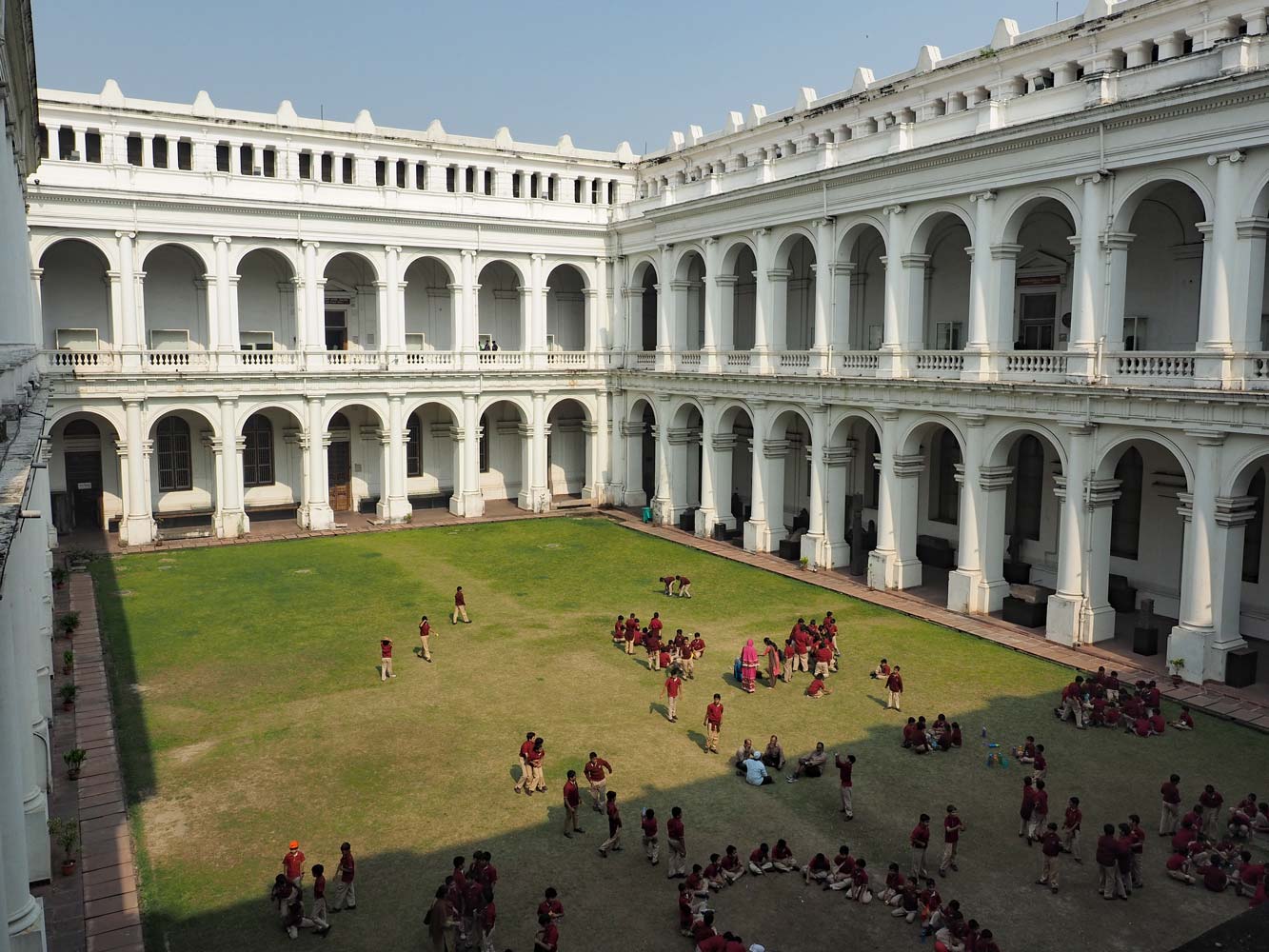
Schoolkids take a
break on the lawn of the central courtyard at India Museum.
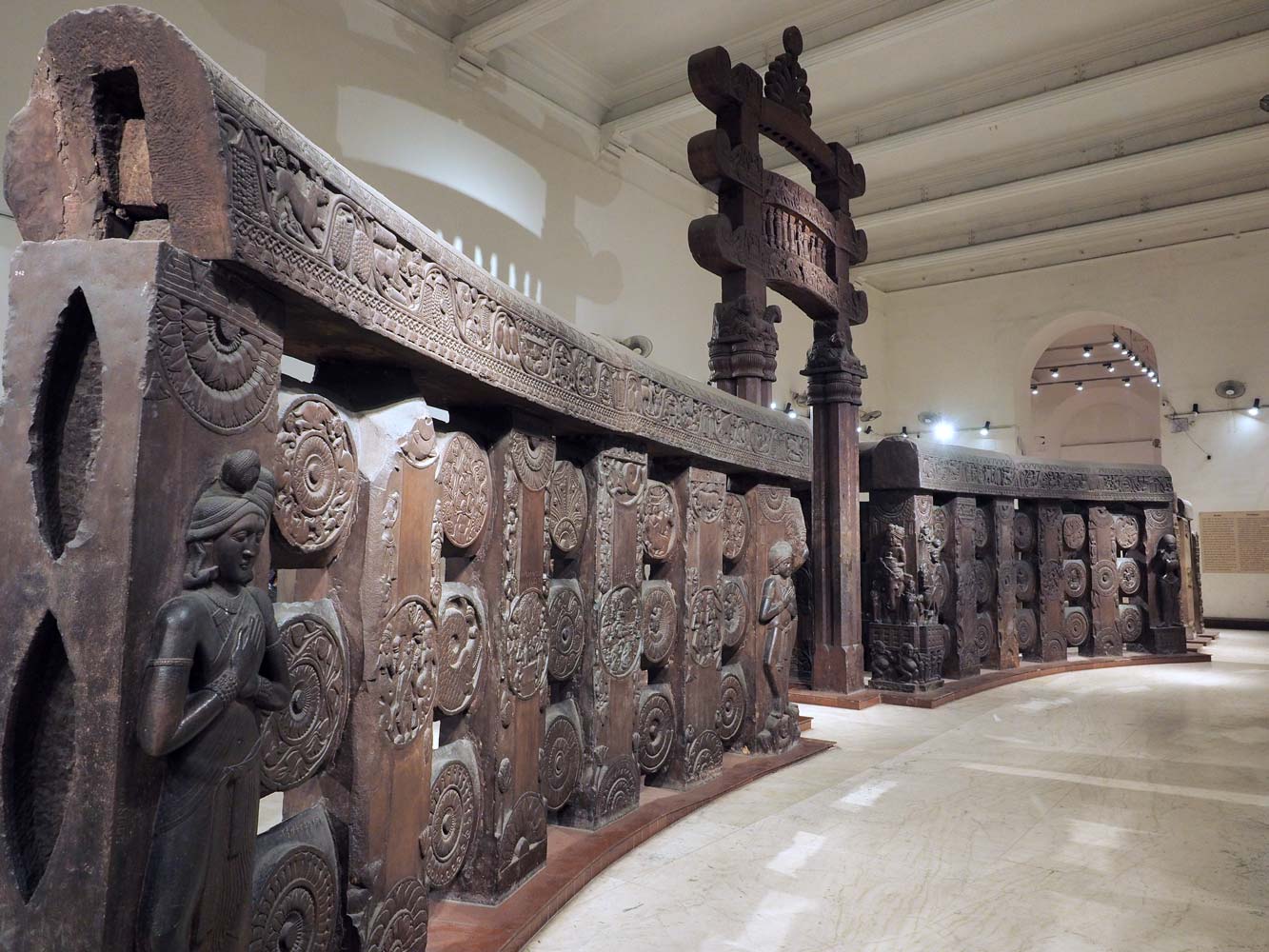
Barhut Stupa
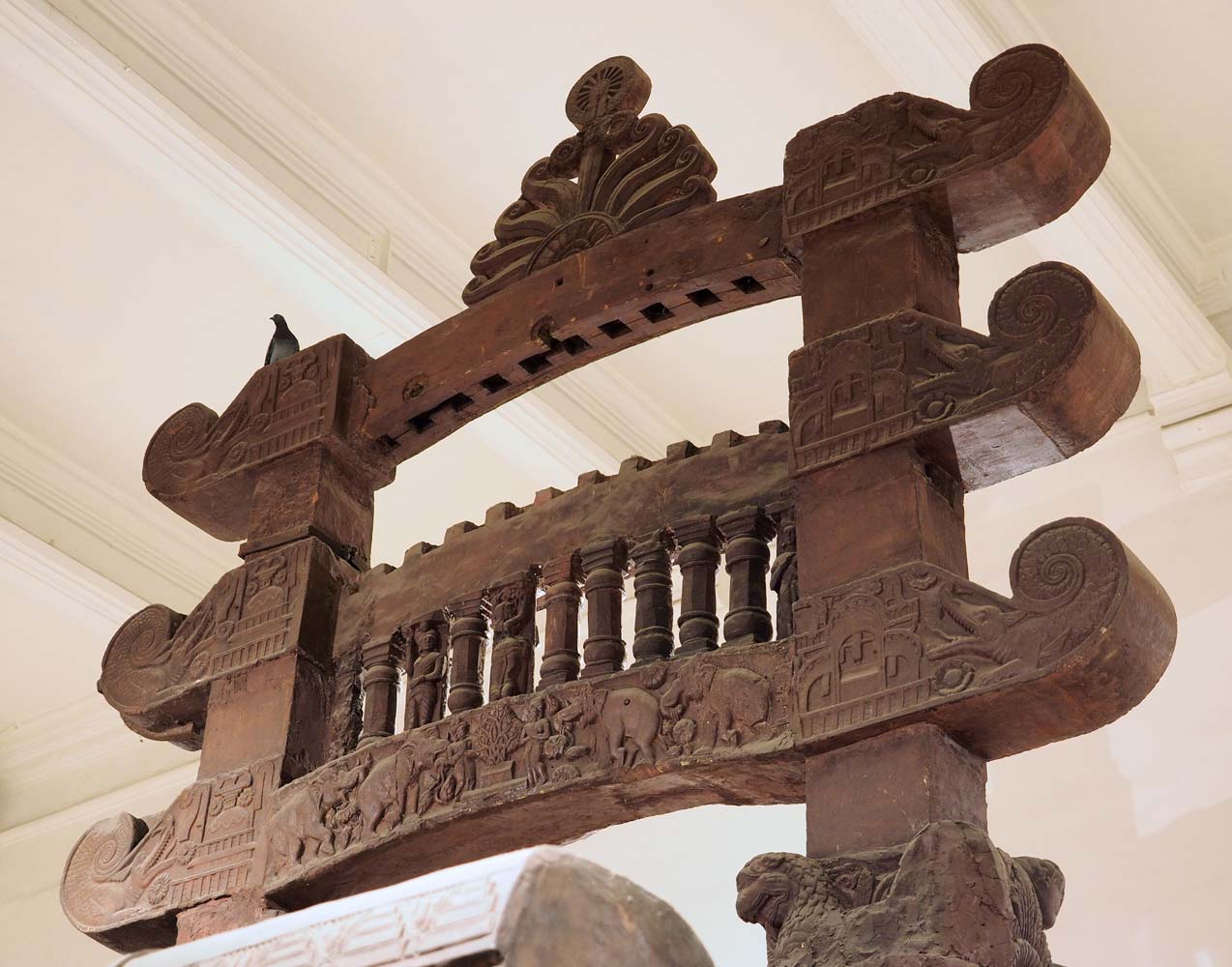
Detail of east
gate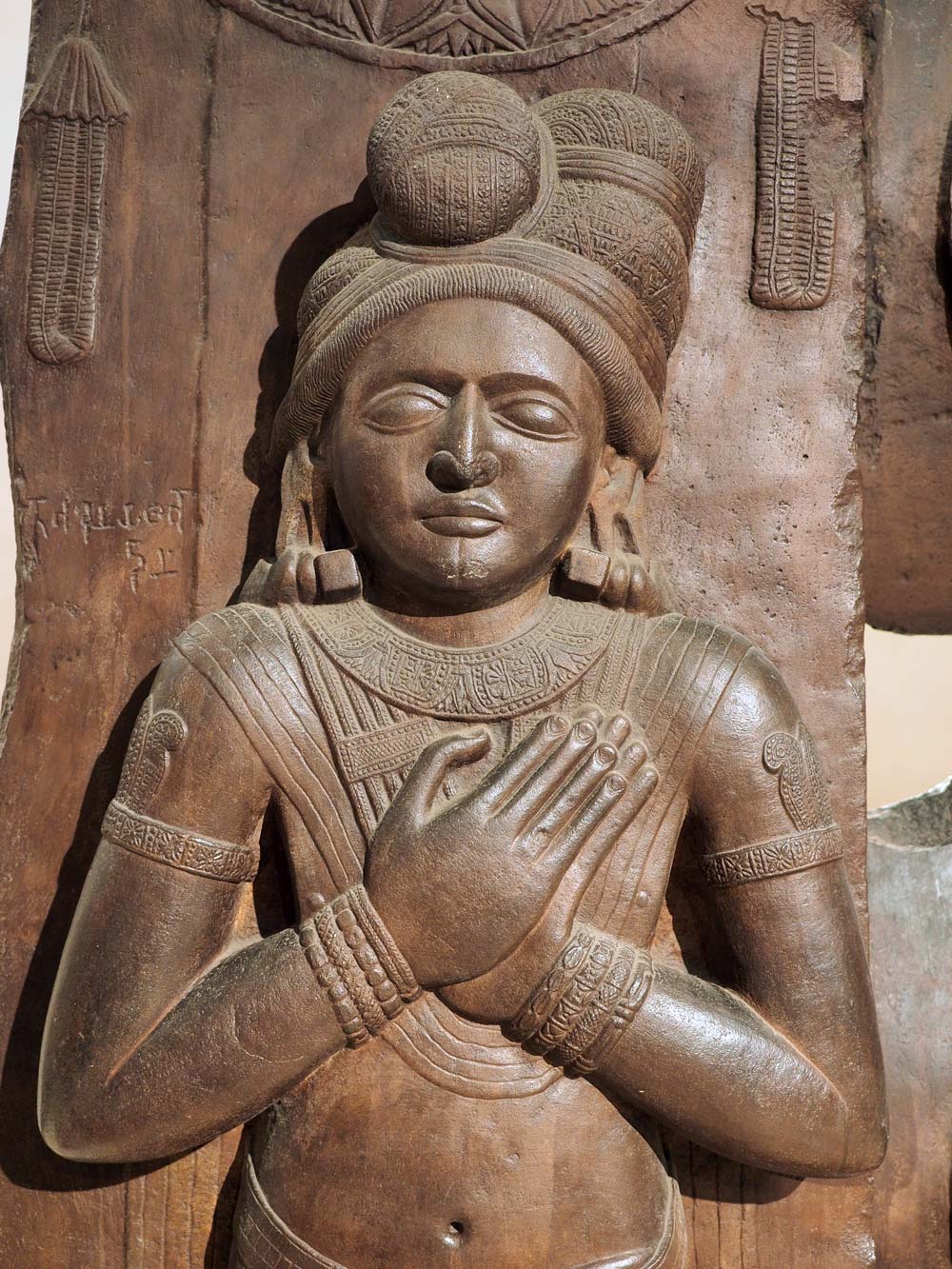
A man
from long ago on a column
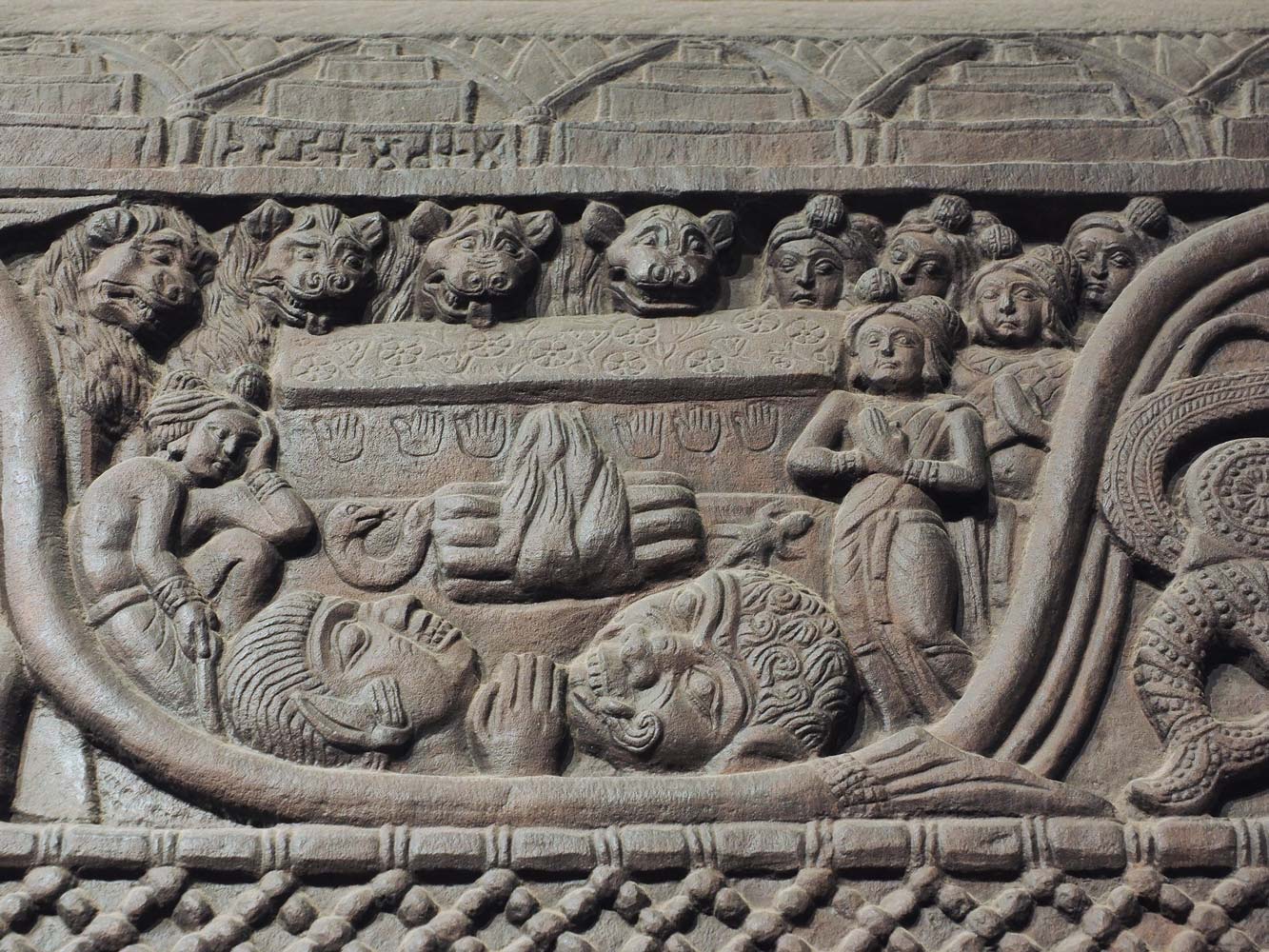
A very strange
scene!
Natural history exhibits tend to be old-fashioned and some appeal only to specialists, but the Siwalik Vertebrate Fossil room contains several huge creatures, as do the amphibian, reptile, bird, and fish galleries. A mummy is the centerpiece of the compact Egypt exhibition, from where I continued into a massive hall of textiles and decorative arts—a section I hadn’t seen before. Stairs led up to the second floor and a large collection of colorful masks. There’s a painting collection too, with a hall of works by miniature schools and a room containing works mainly from the first half of the 20th century. I’m very fond of visiting galleries of ancient stone sculptures that depict gods and teachers of the Hindu, Buddhist, and Jain religions. By closing time I had been wandering the halls for six hours—with breaks—a very satisfying visit. Then to Blue Sky Café for a paneer mushroom masala dinner followed by a walk back to my hotel.
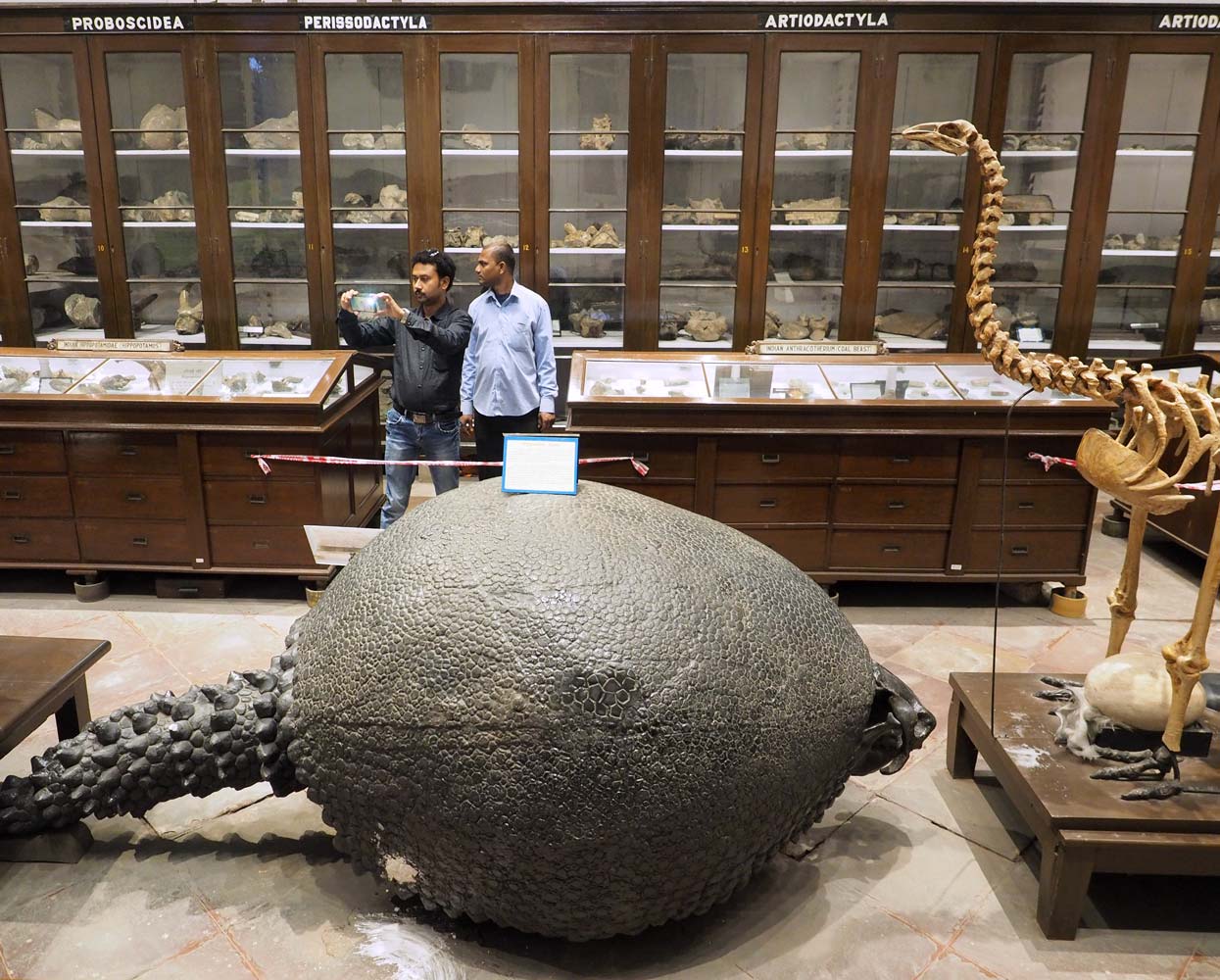
Wonders of nature:
The central fossil is a Glyptodon, a giant relative of armadillos that
lived during the Pleistocene epoch.
On the right is a Dinornis
elephantopus, a giant wingless bird that flourished in New Zealand about 800
years ago until exterminated by natives; a cast of its super-sized egg is
beneath it.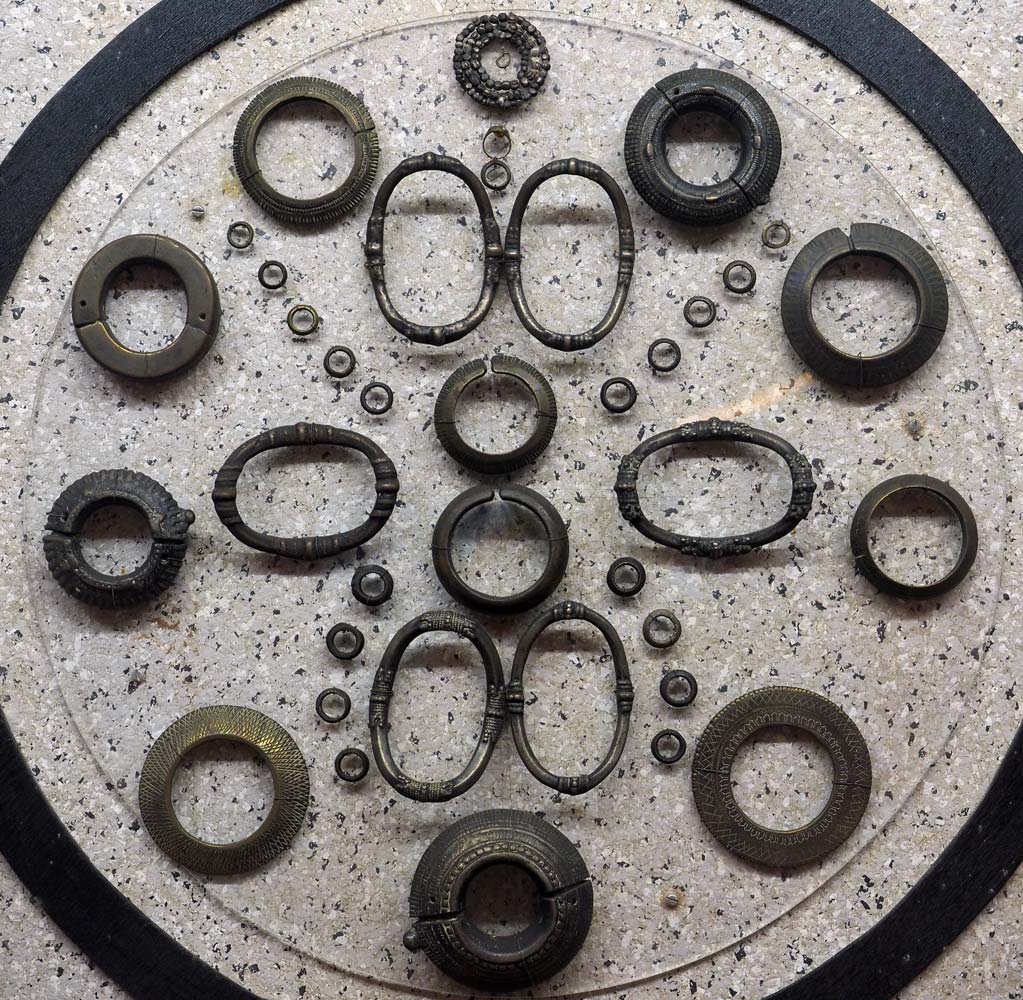
These ornaments weighing 7.2 kilograms were found in the stomach of an estuarine
crocodile.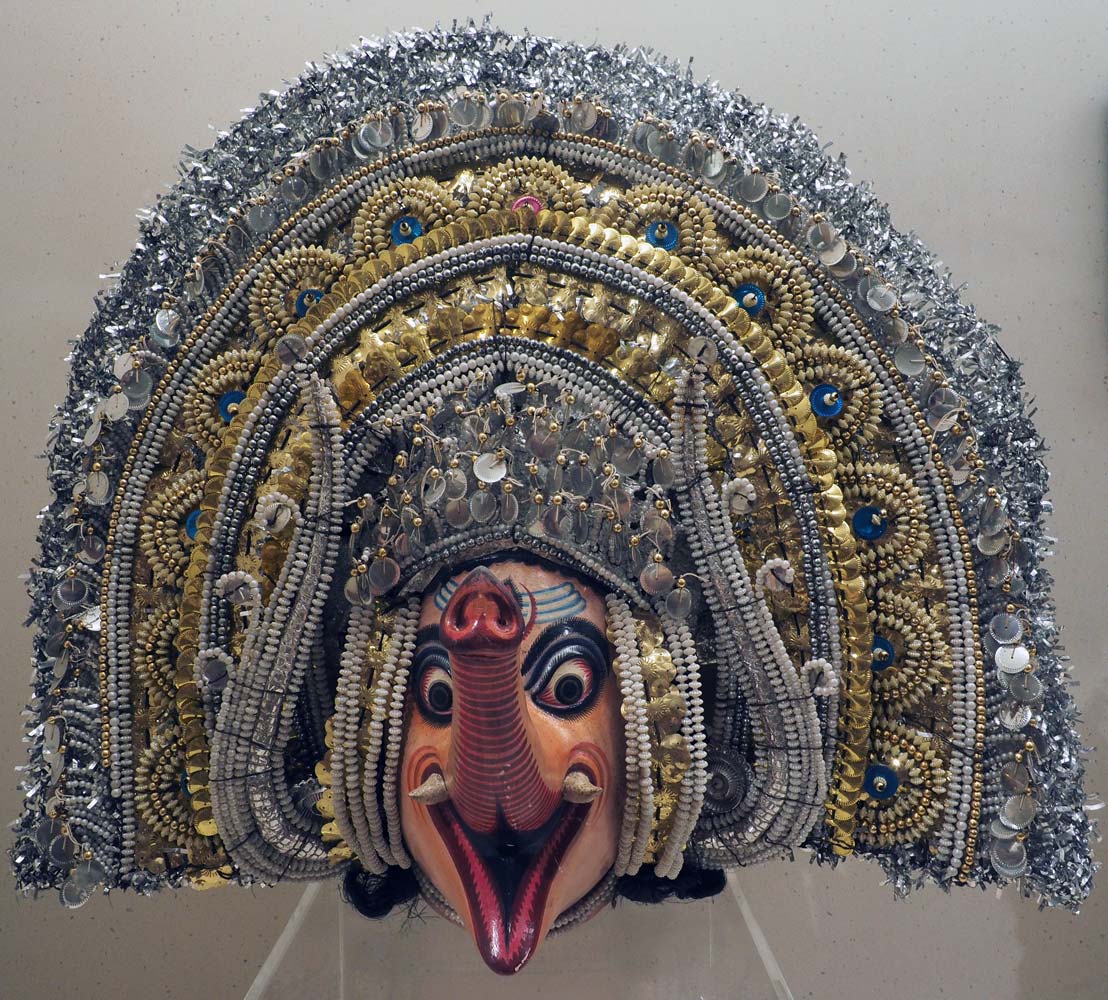
Ganesh mask from West Bengal used in “Ganesh Bandana” Chou Dance
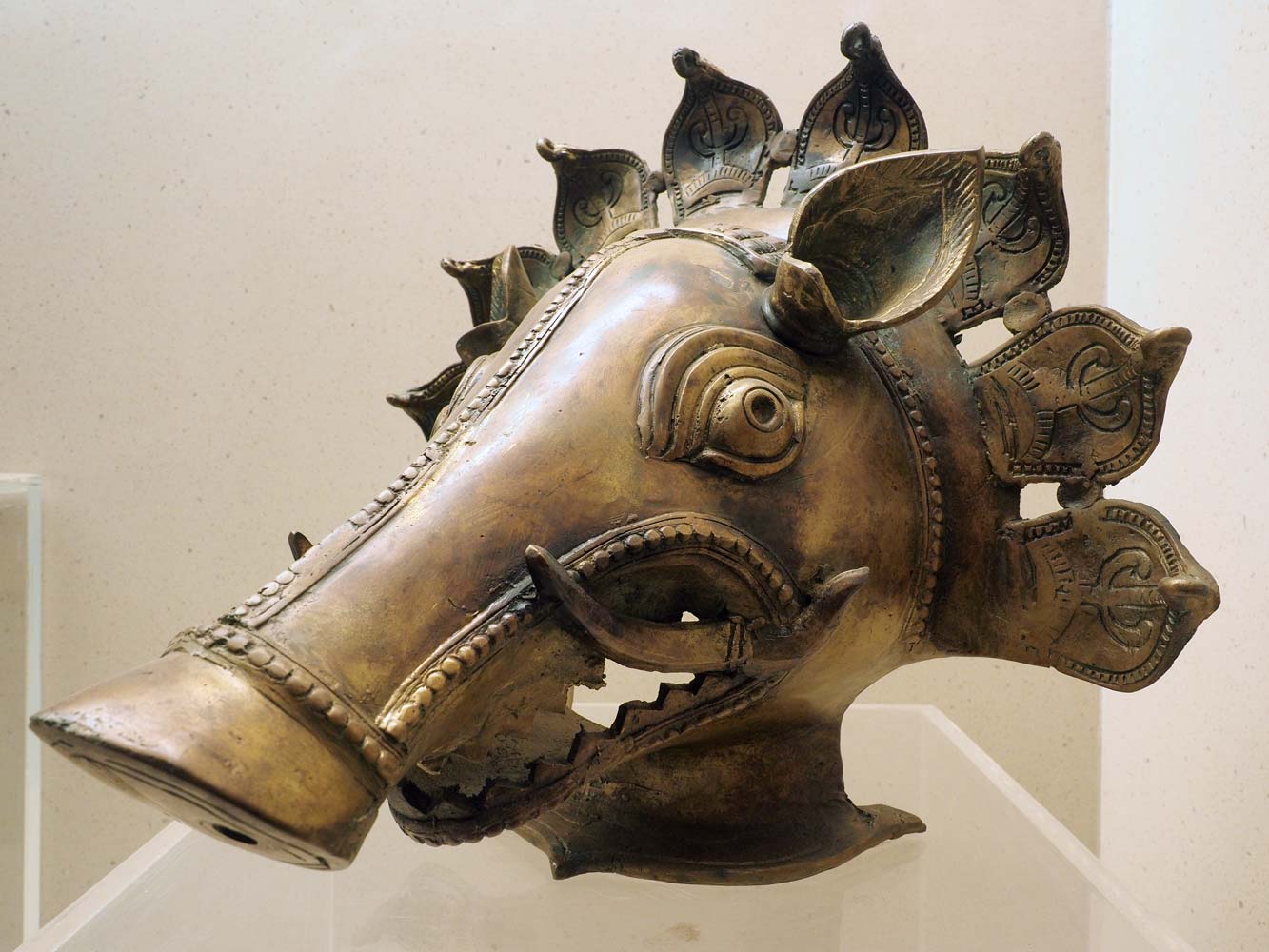
A brass Bhuta Mask
from Karnataka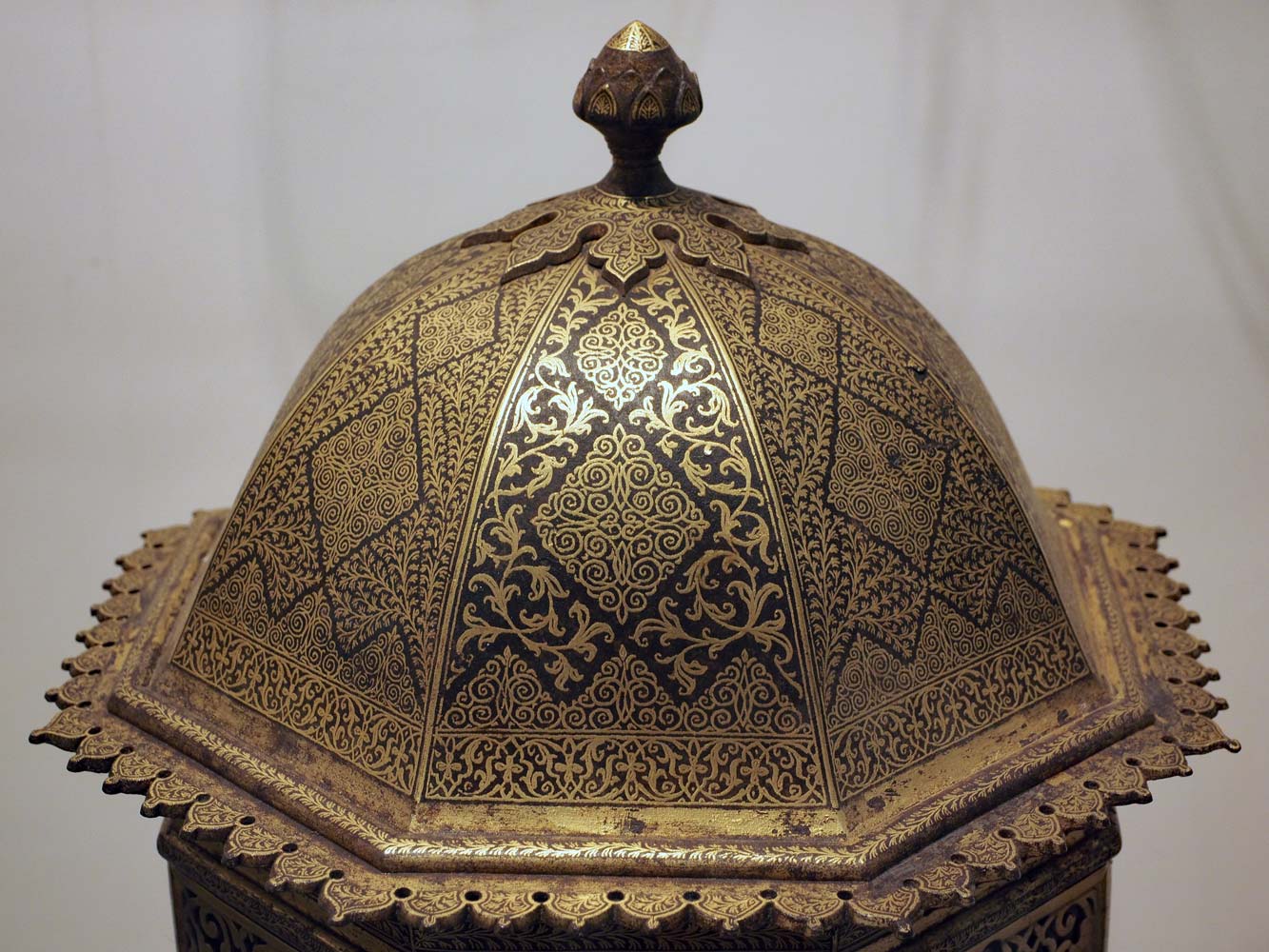
Lid of an early 20th-century box from Lucknow shows floral koftagari decoration
in gold.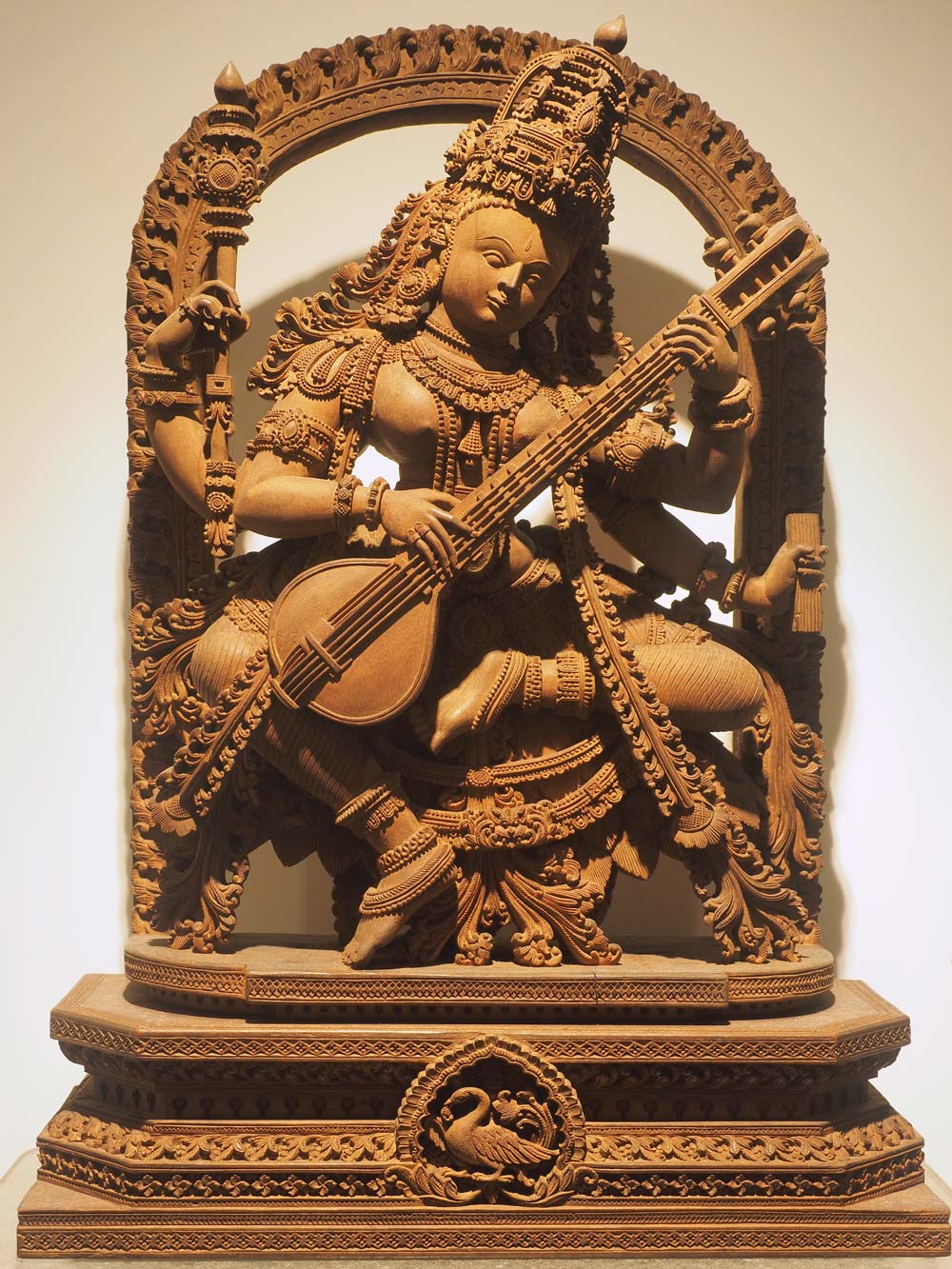
Saraswati plays a veena in this 18th-century sandalwood sculpture from Mysore.
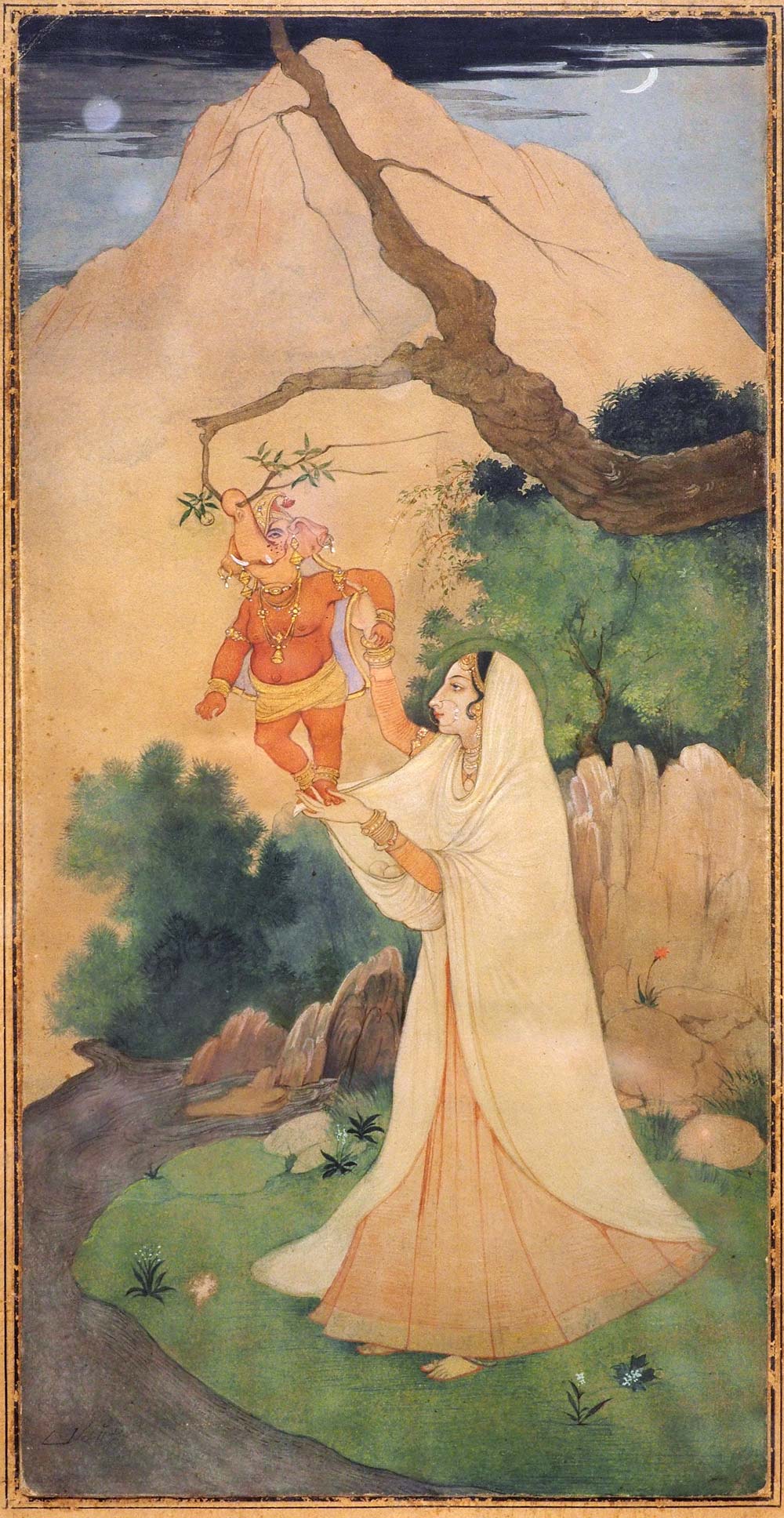
Ganesh
Janani (guache on paper) by Abanindranath Tagore (1871-1951)